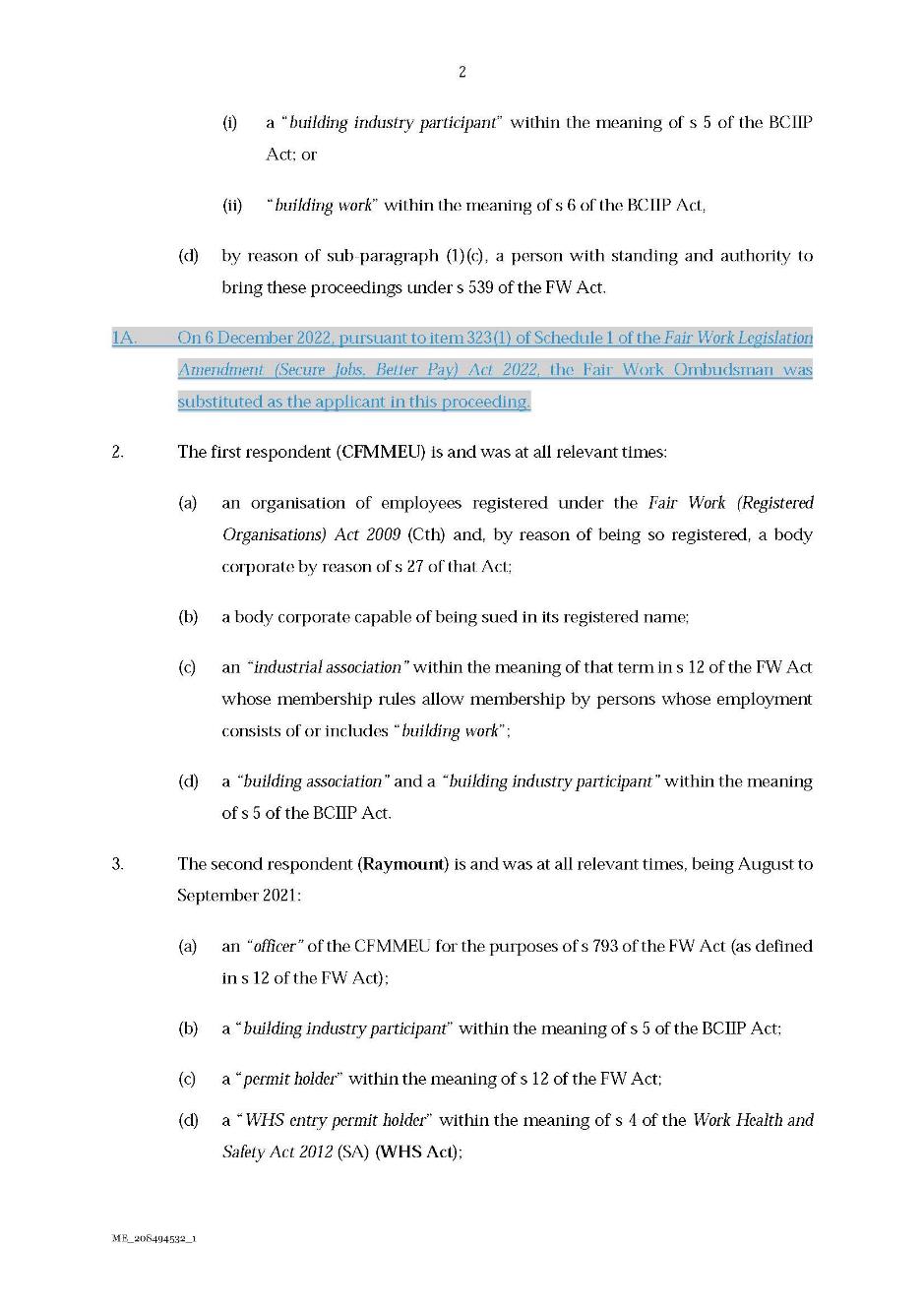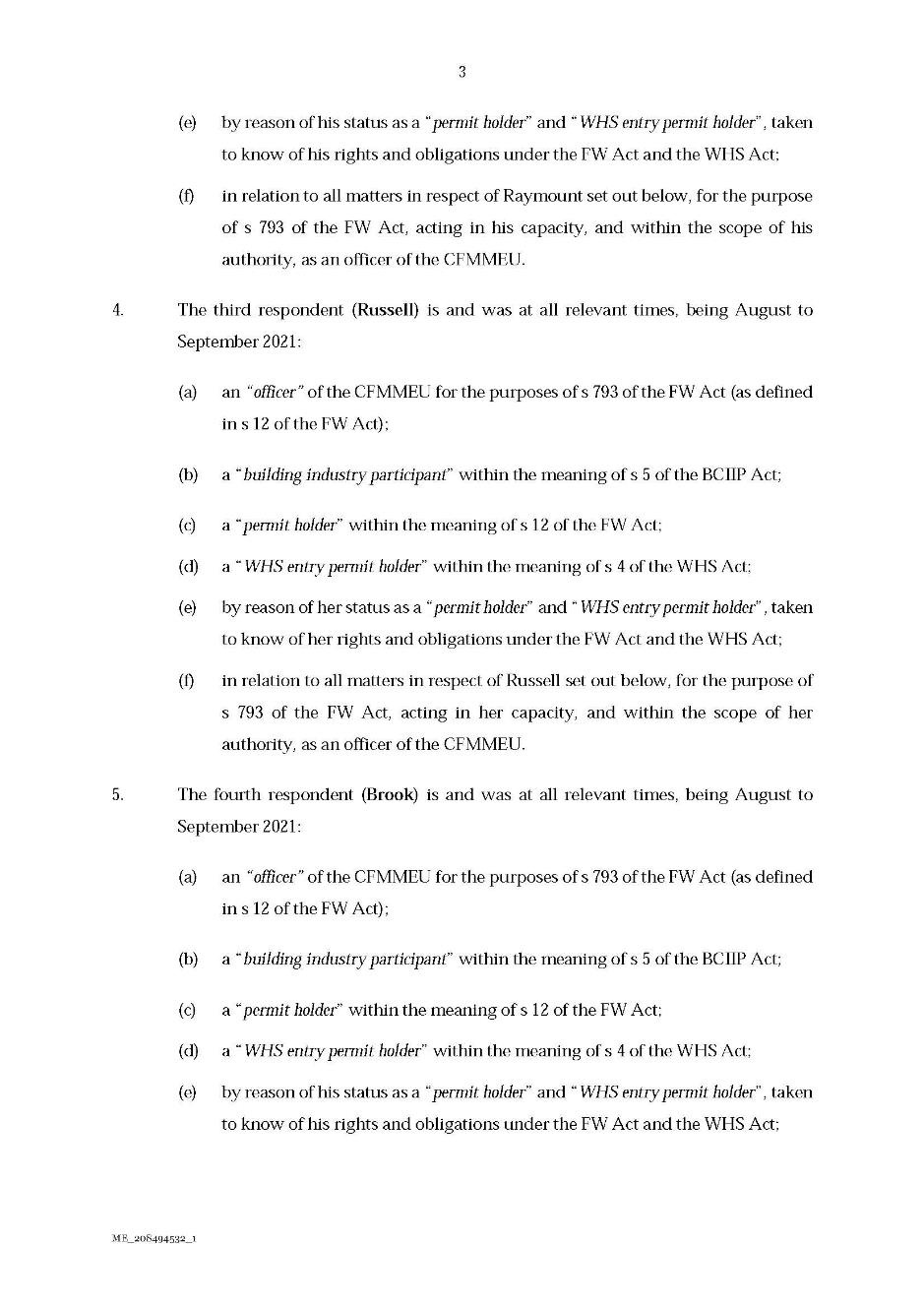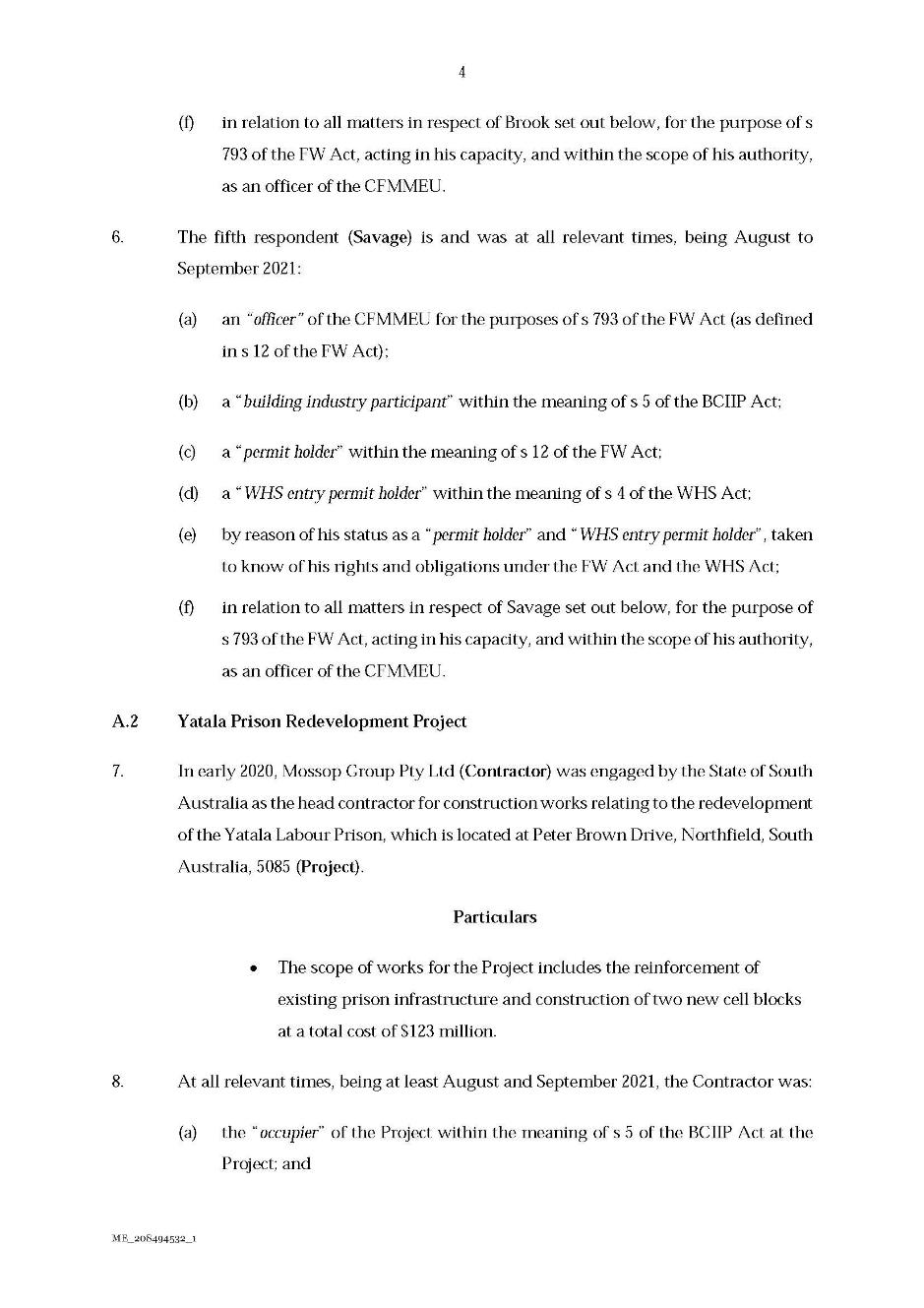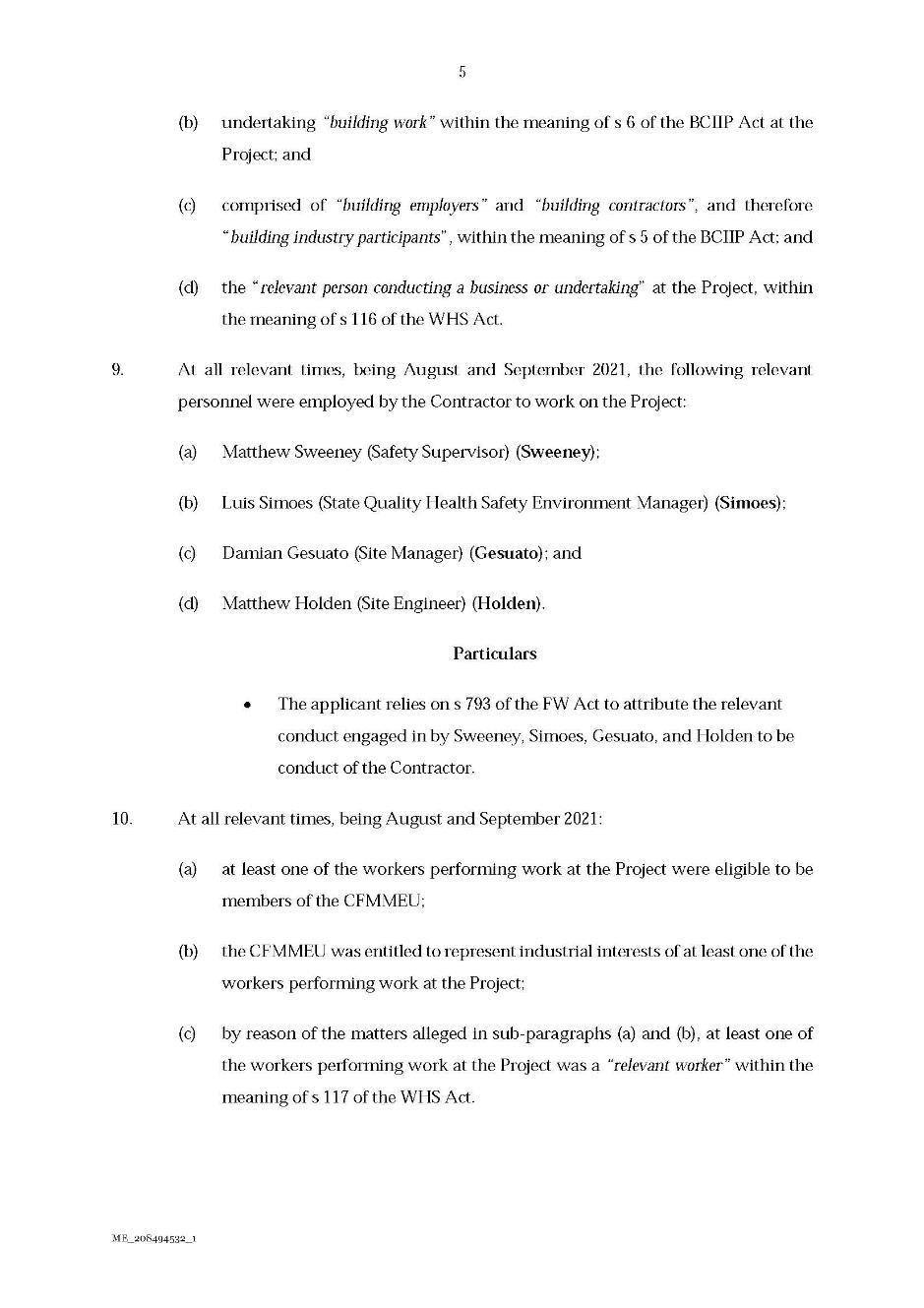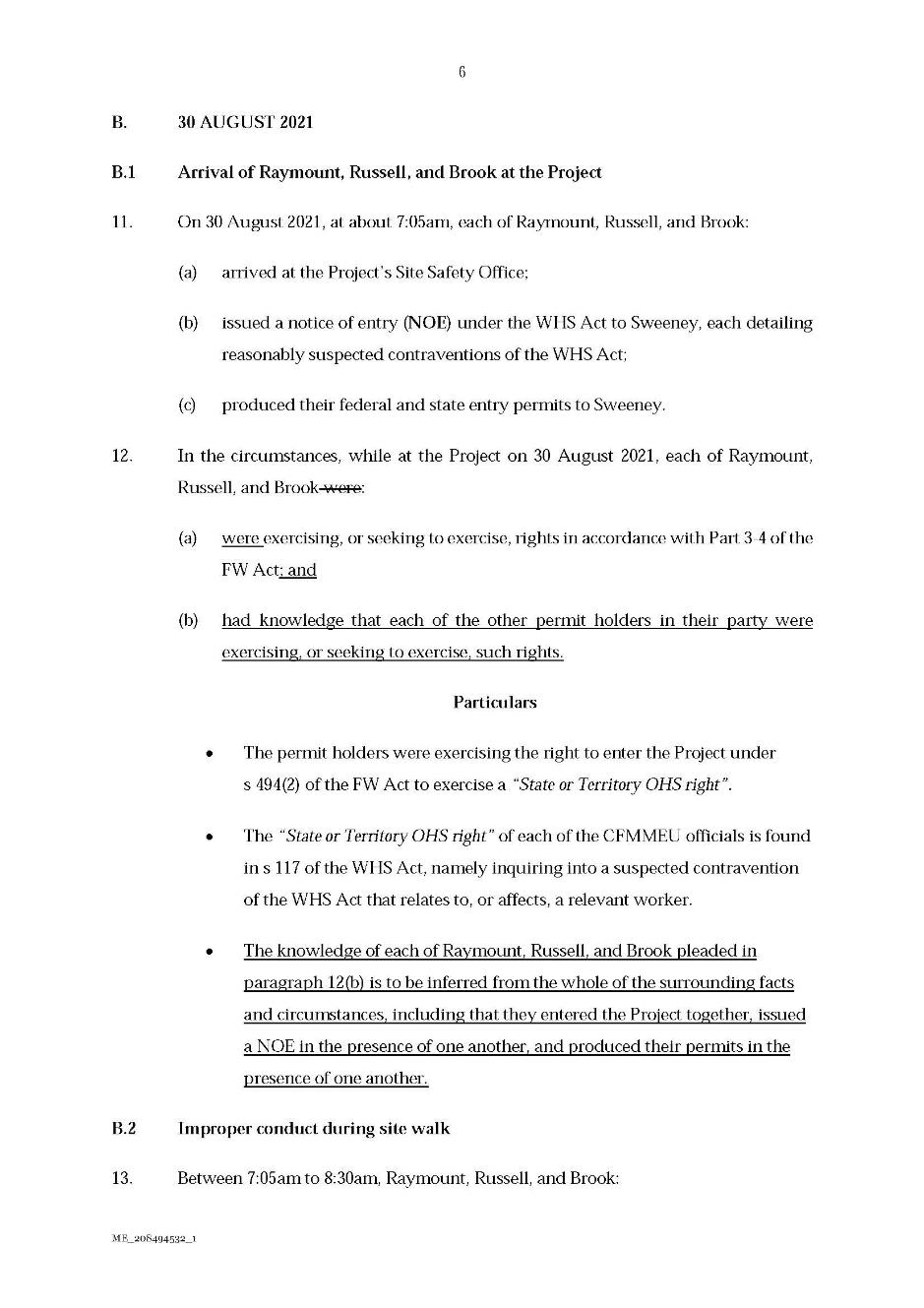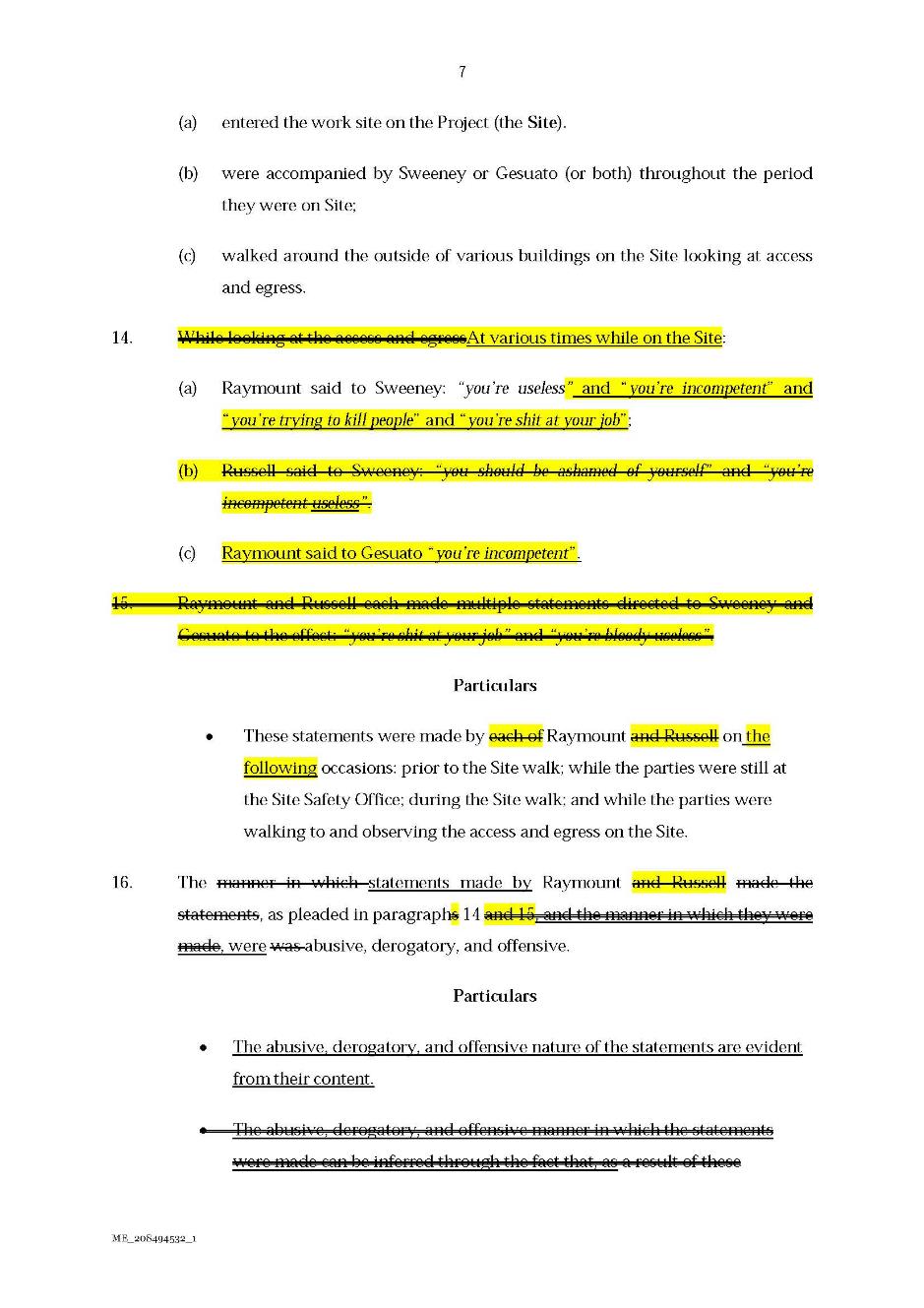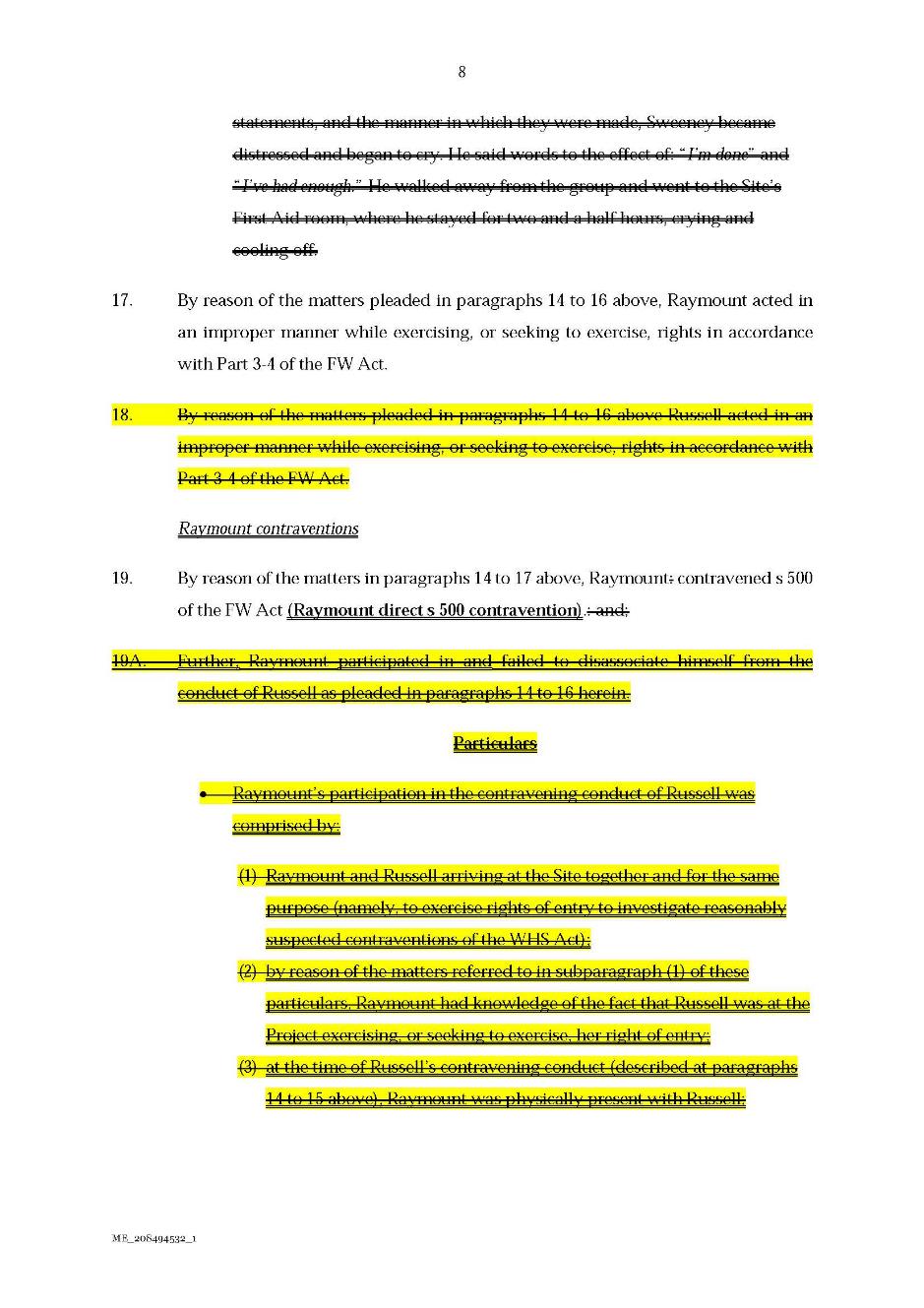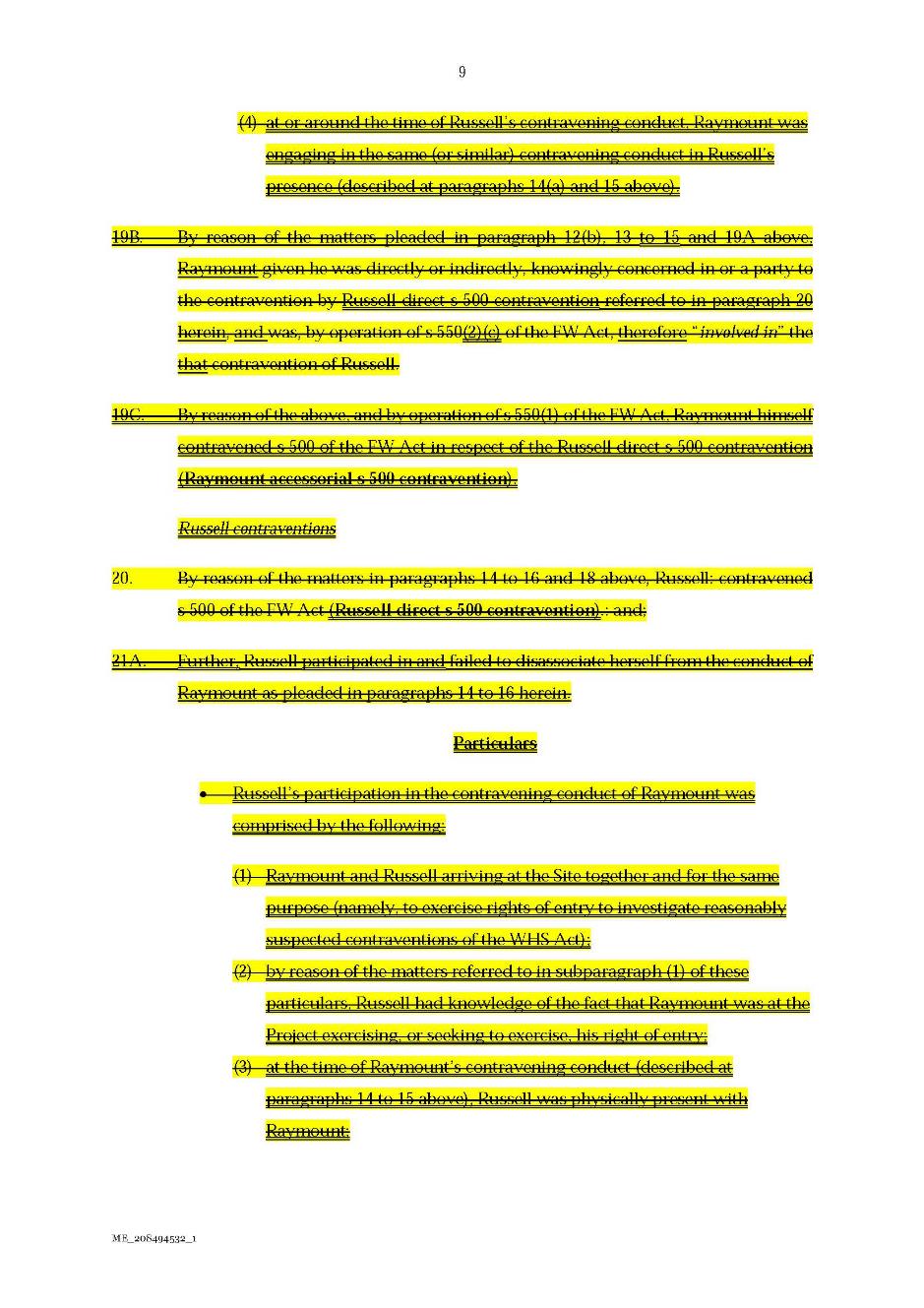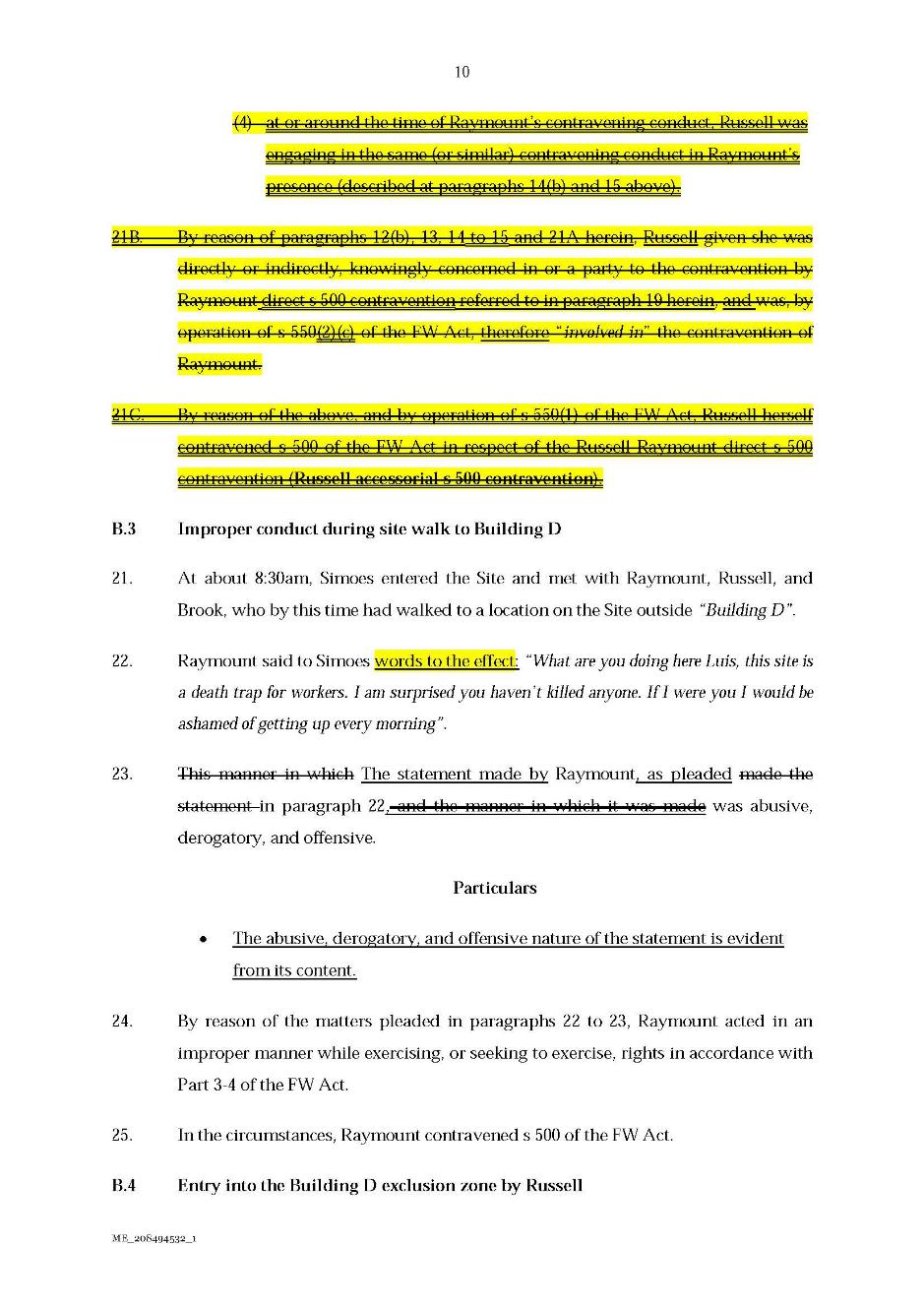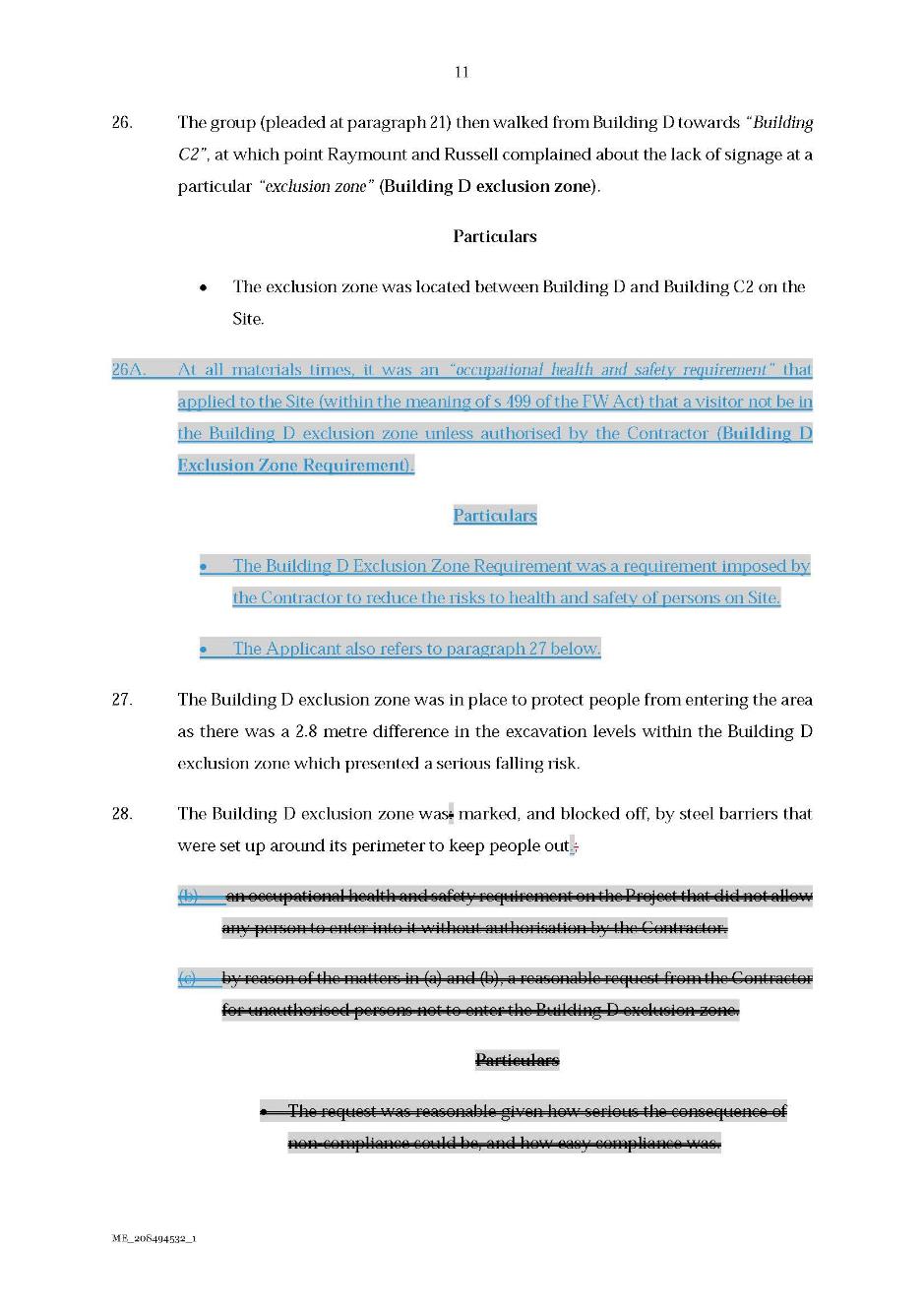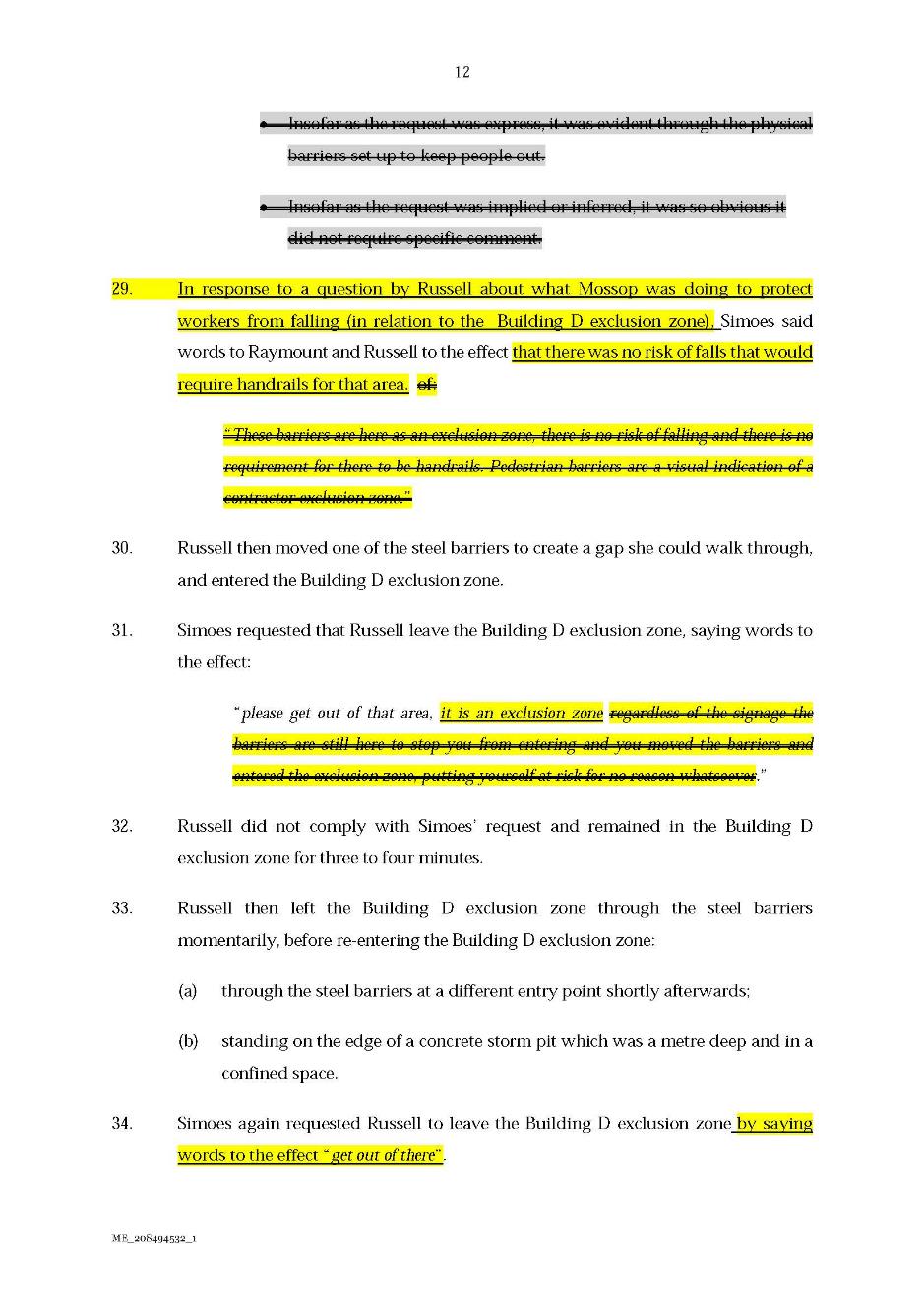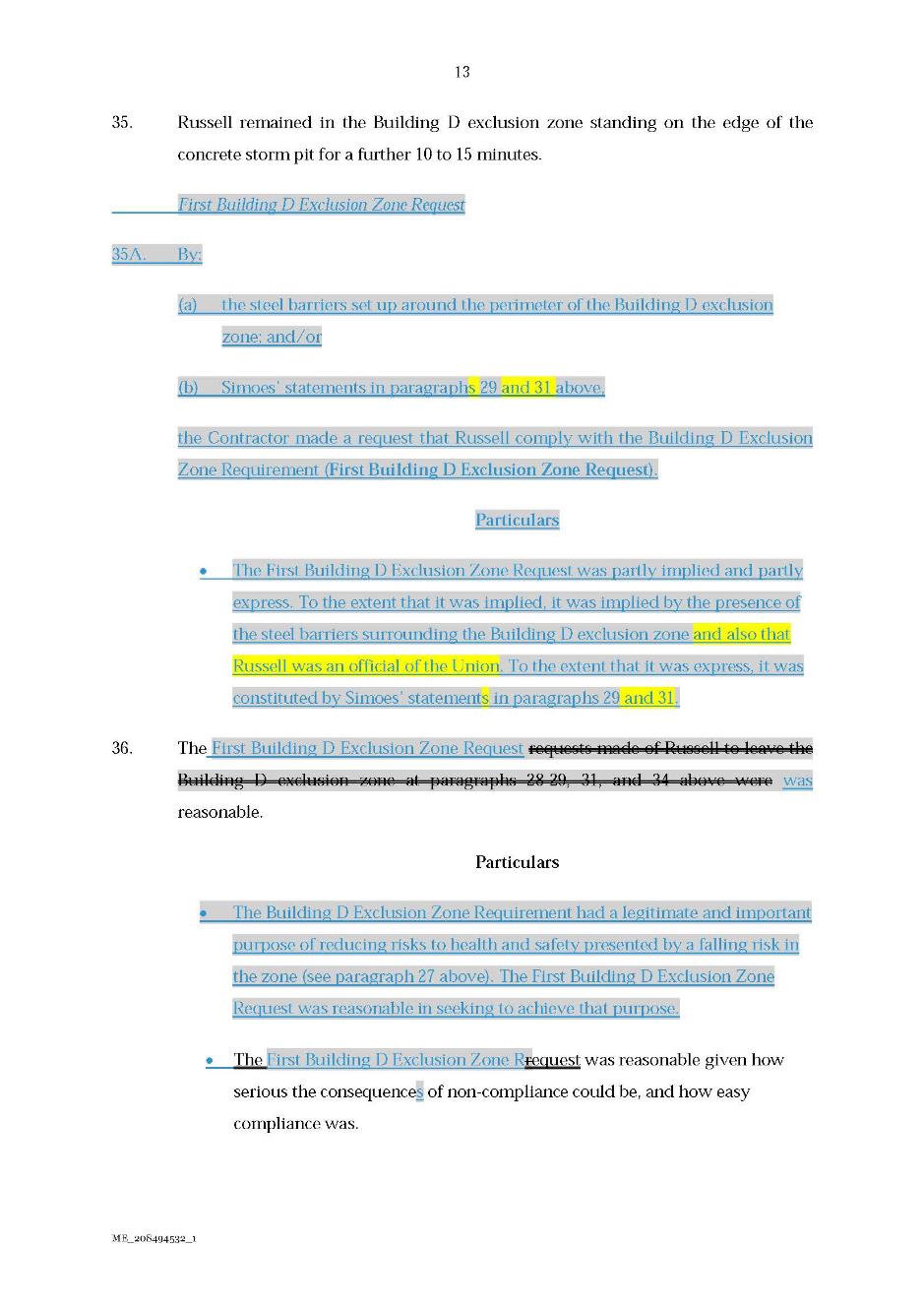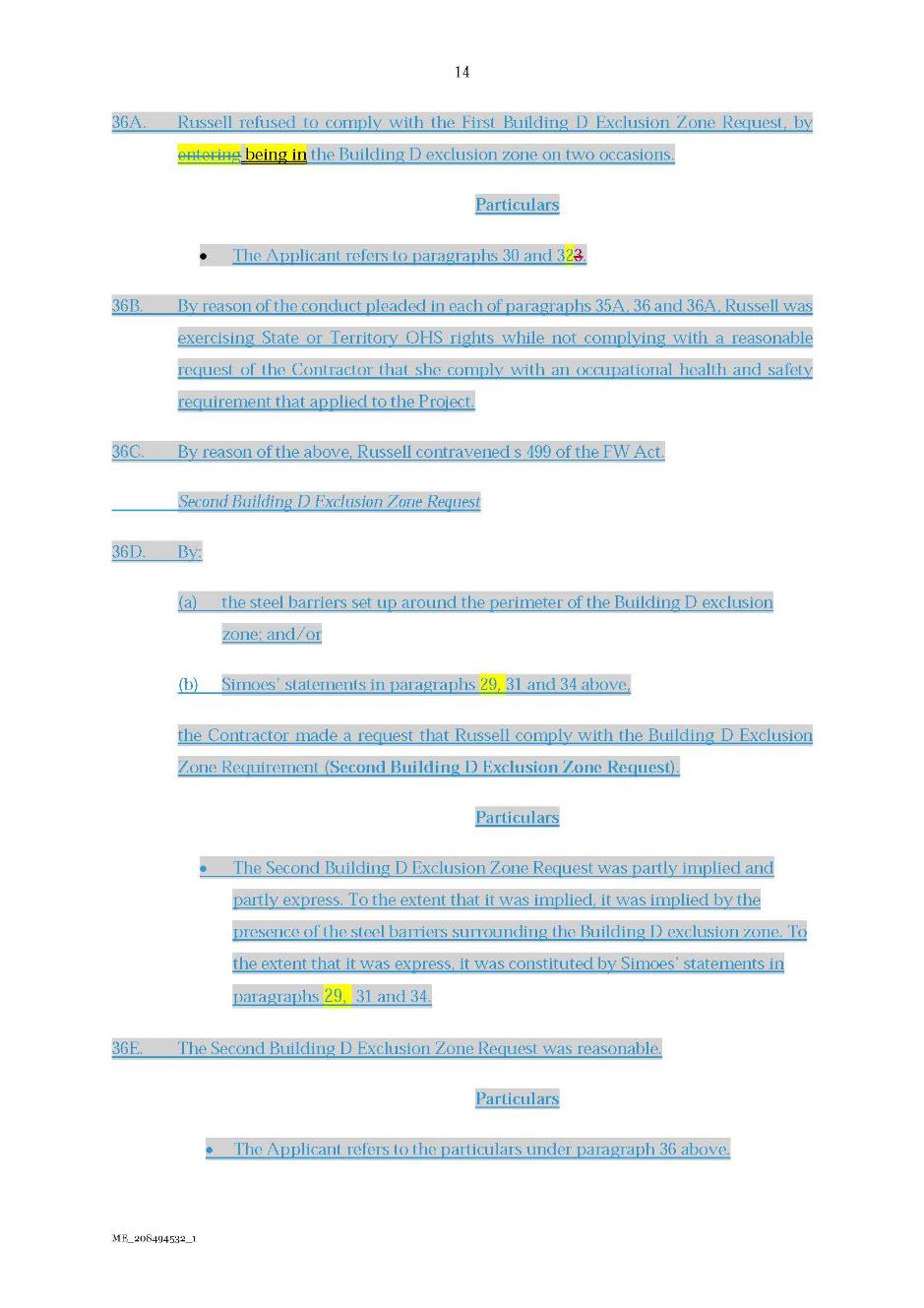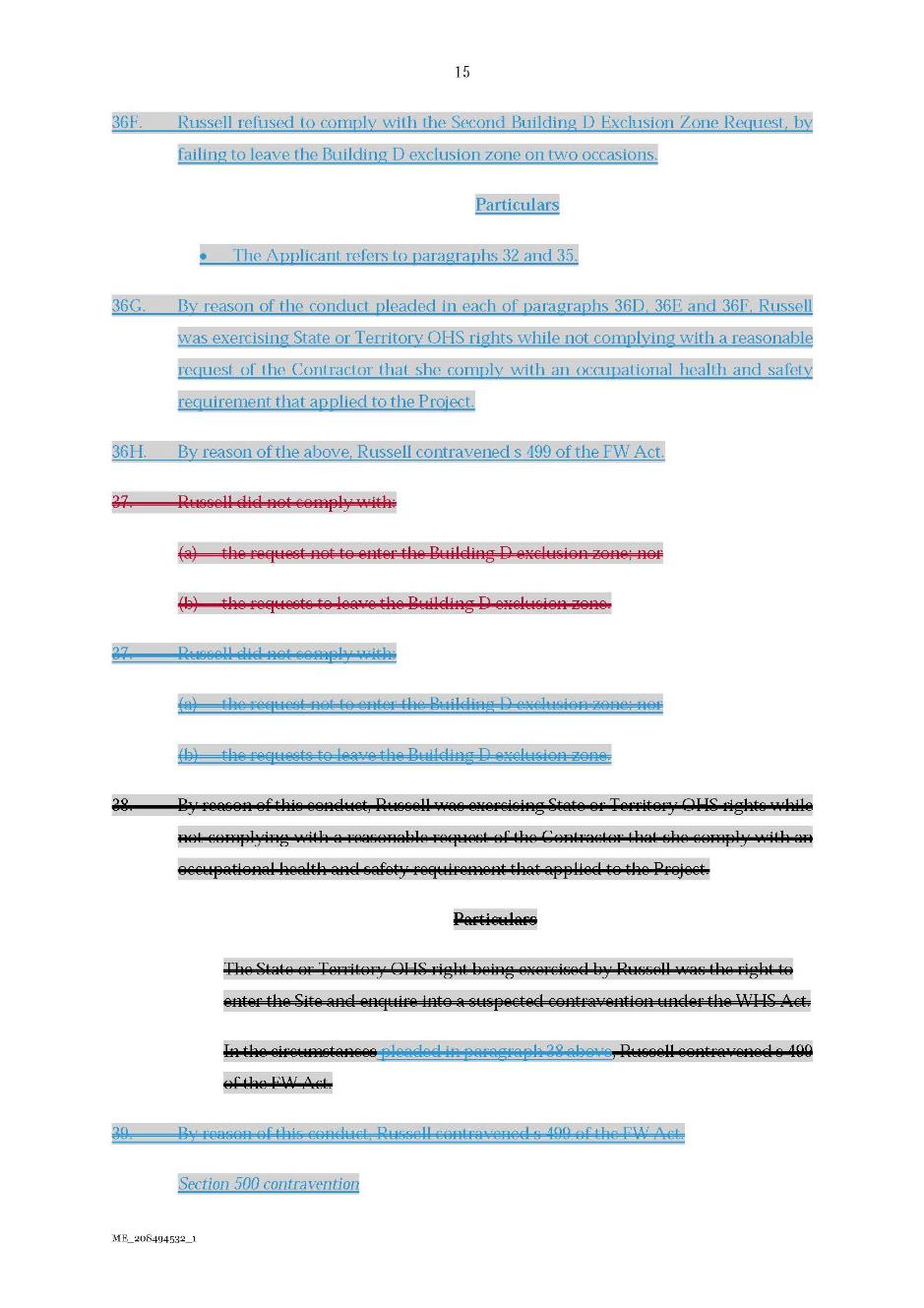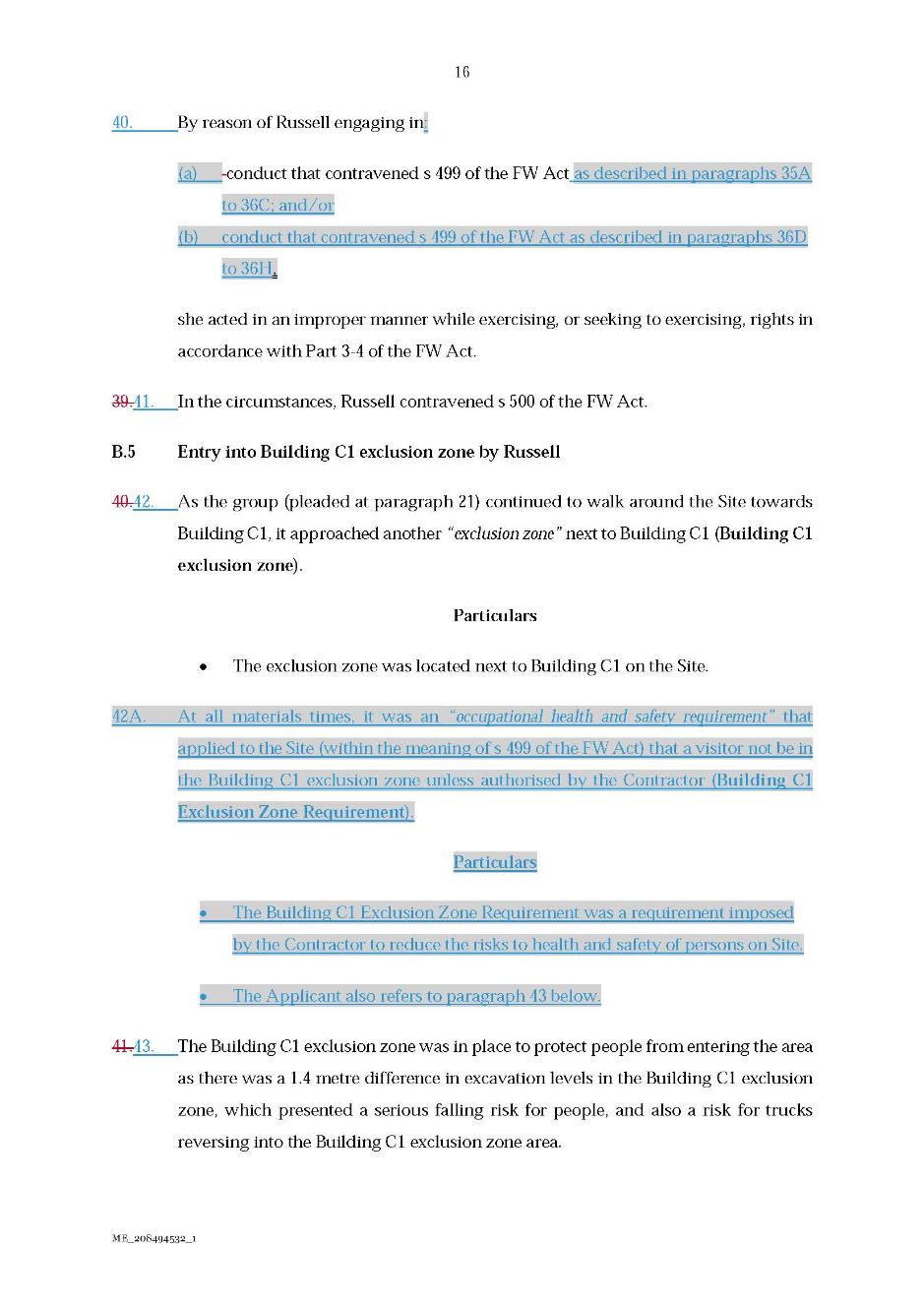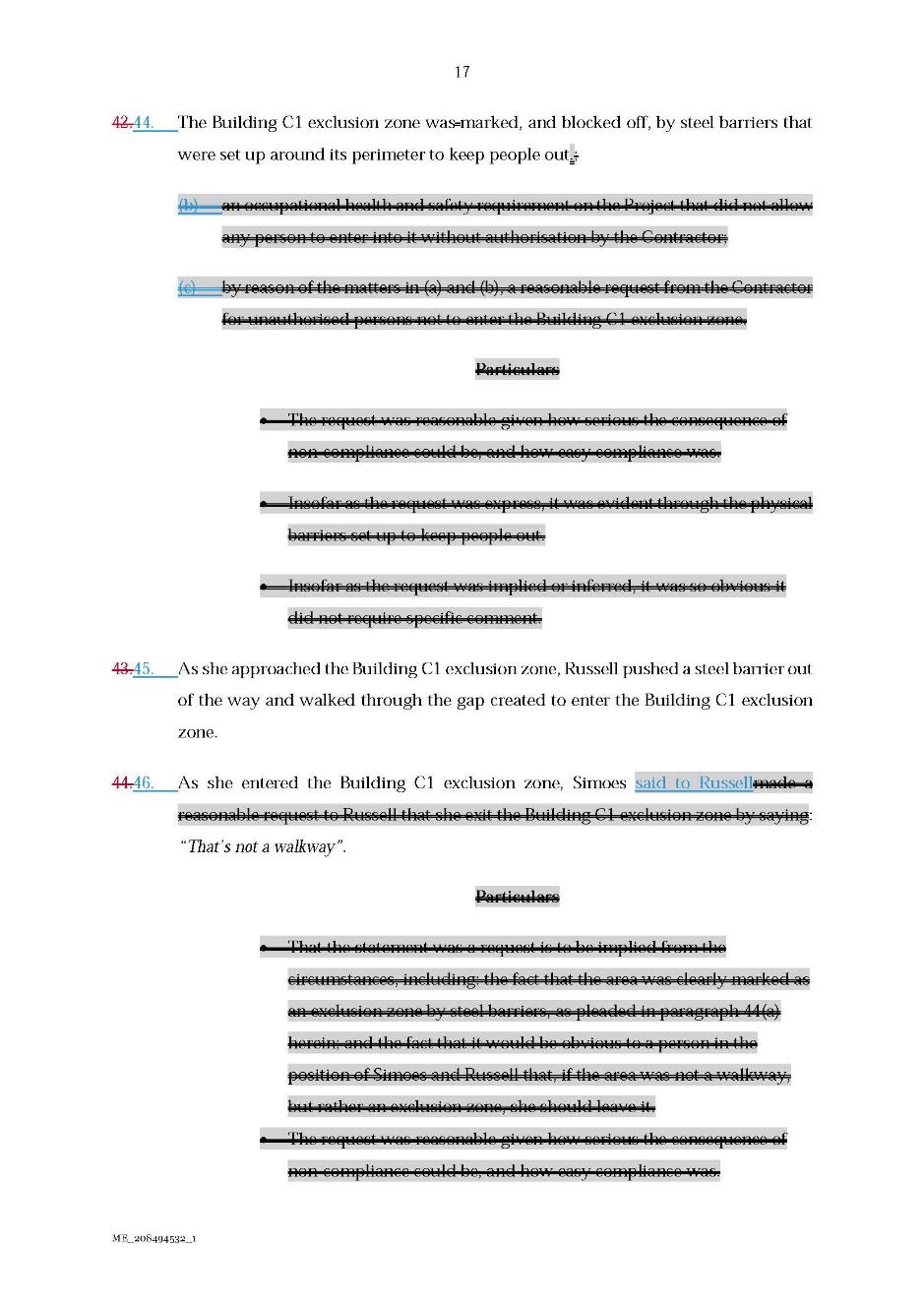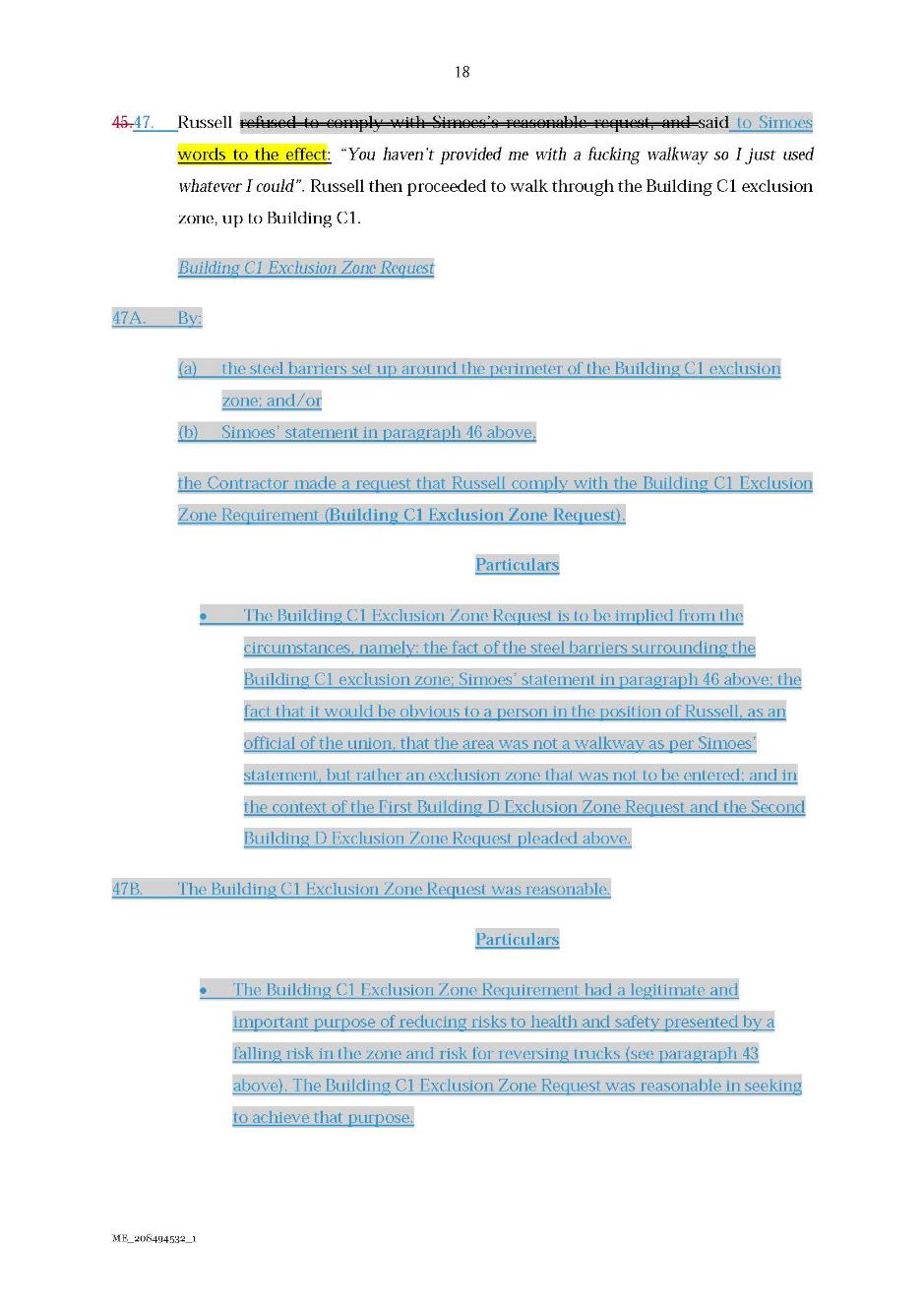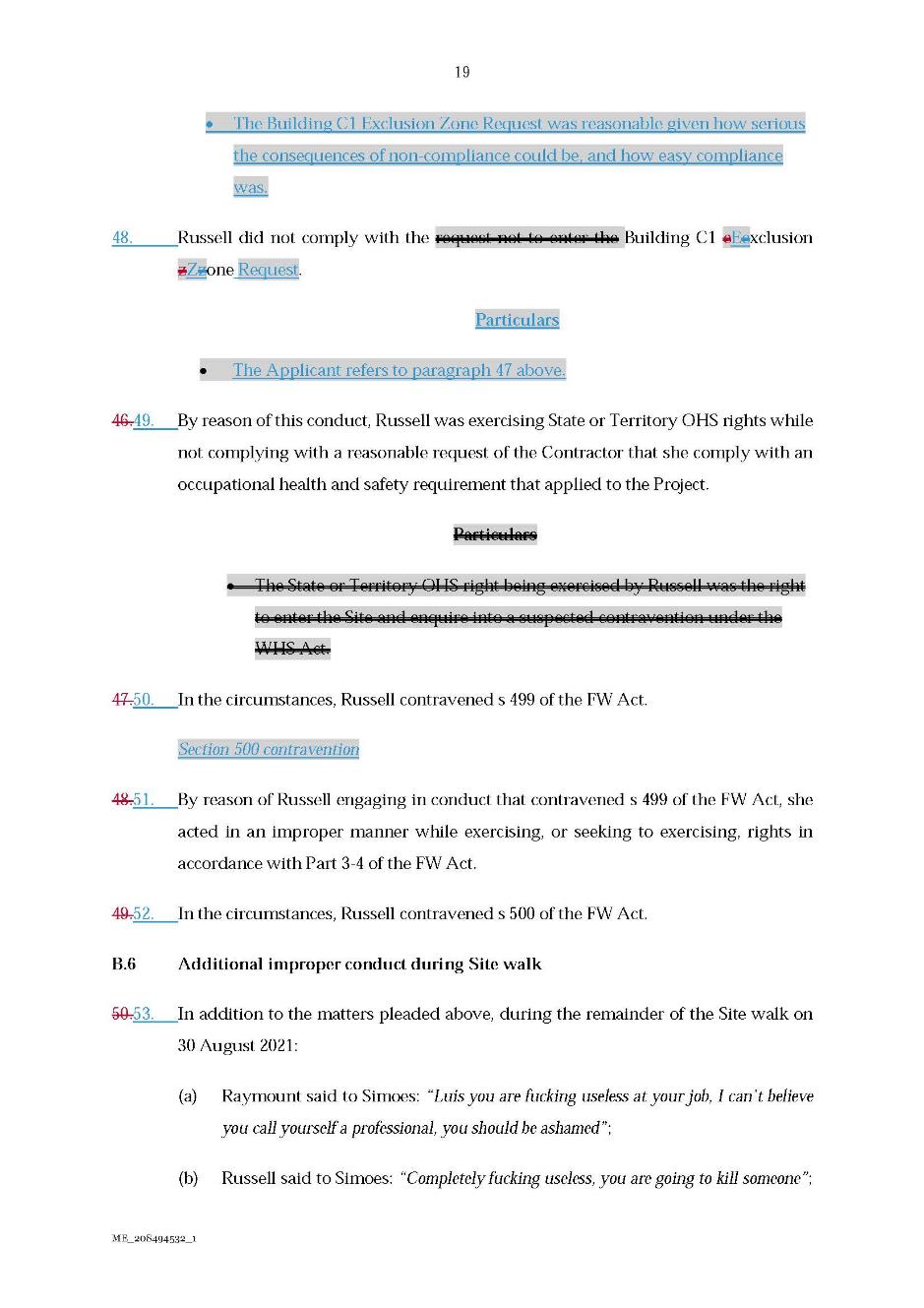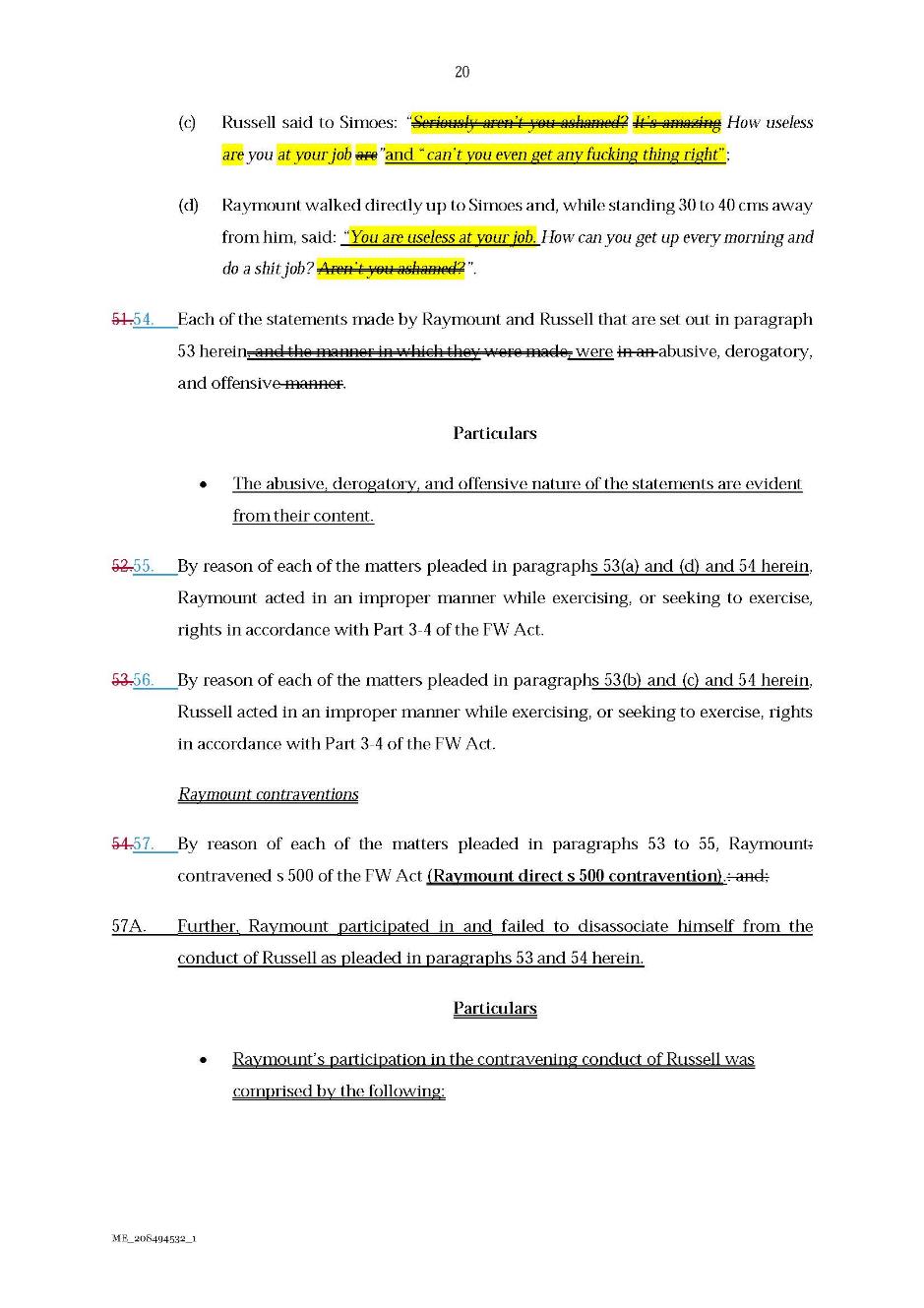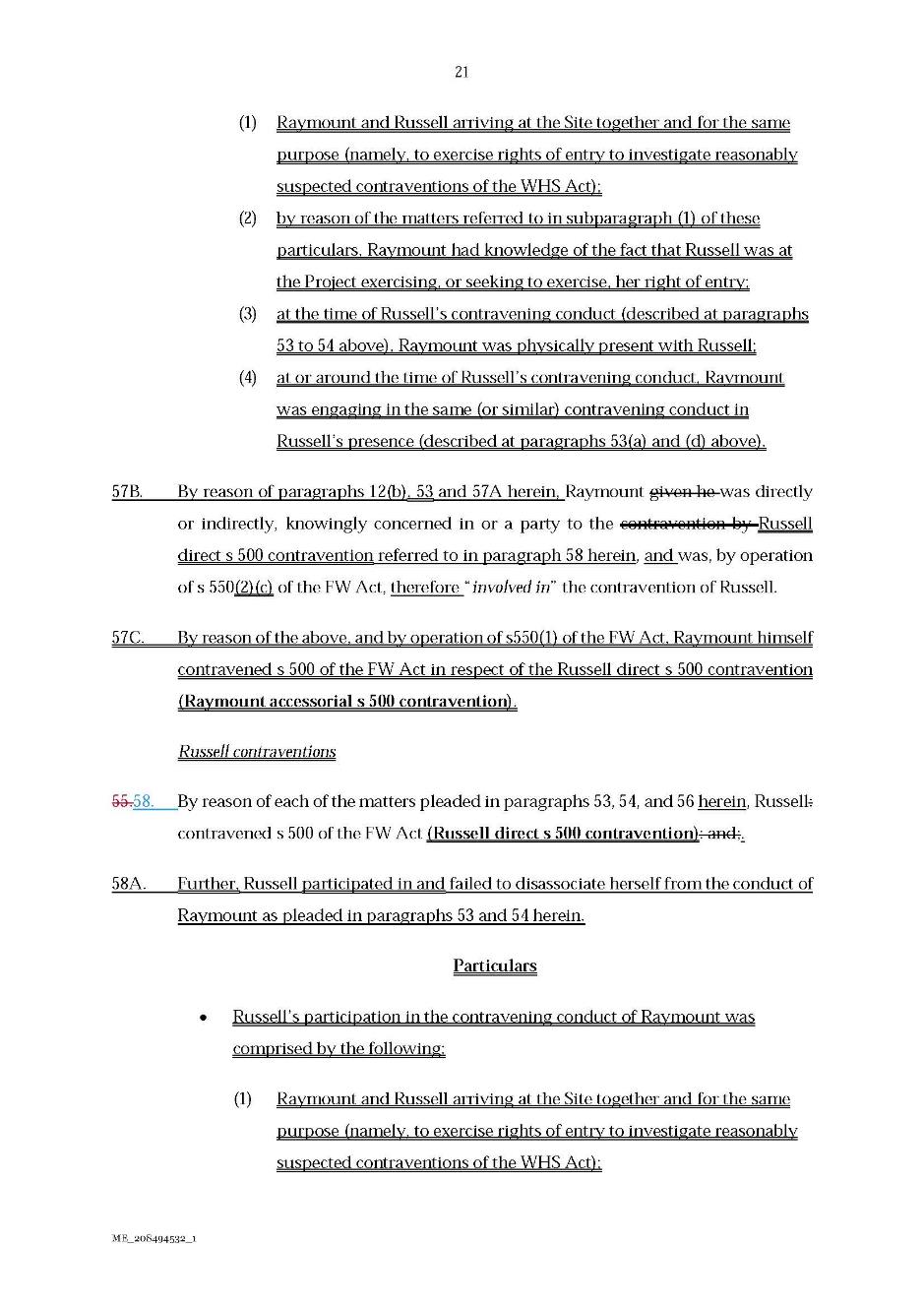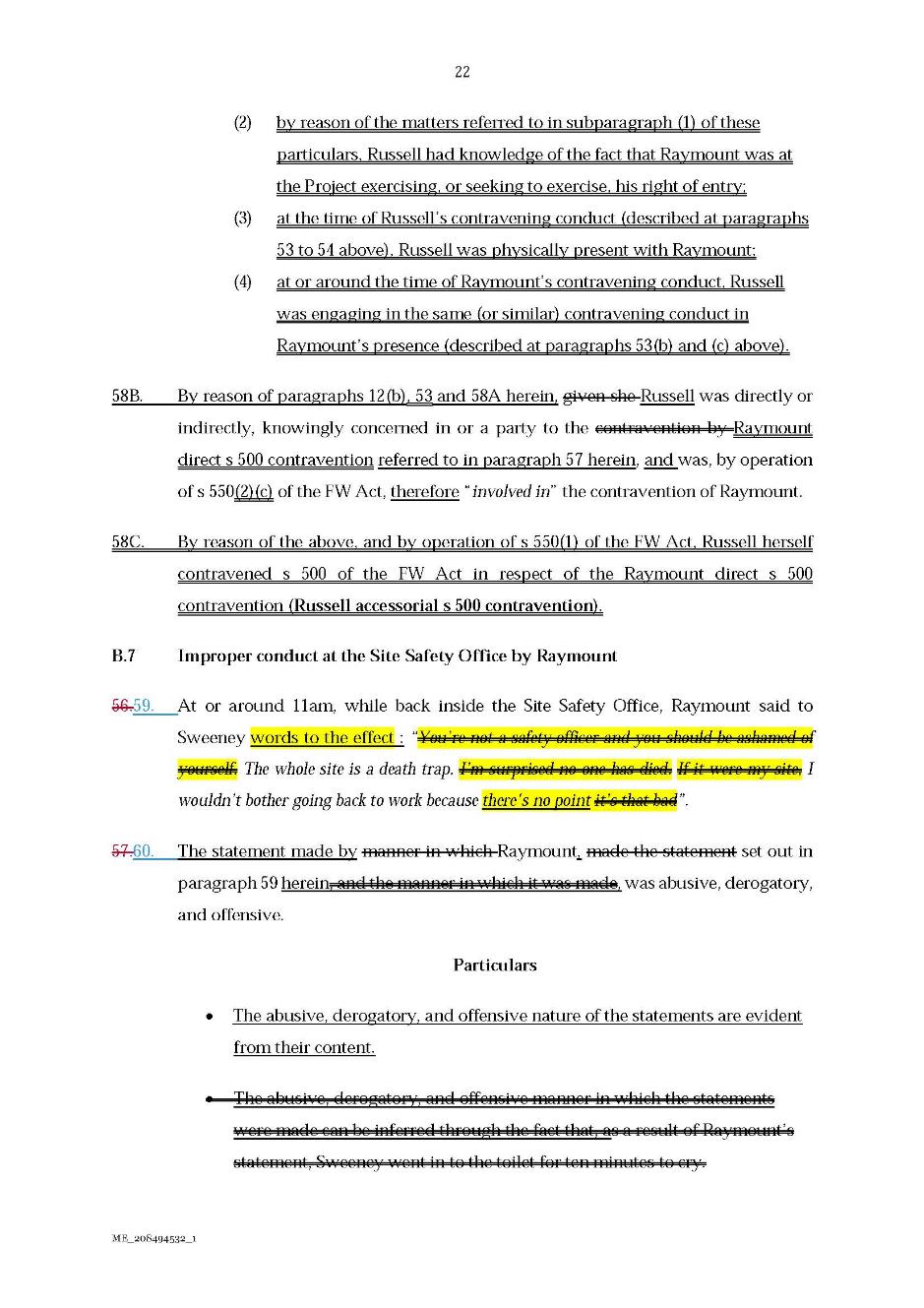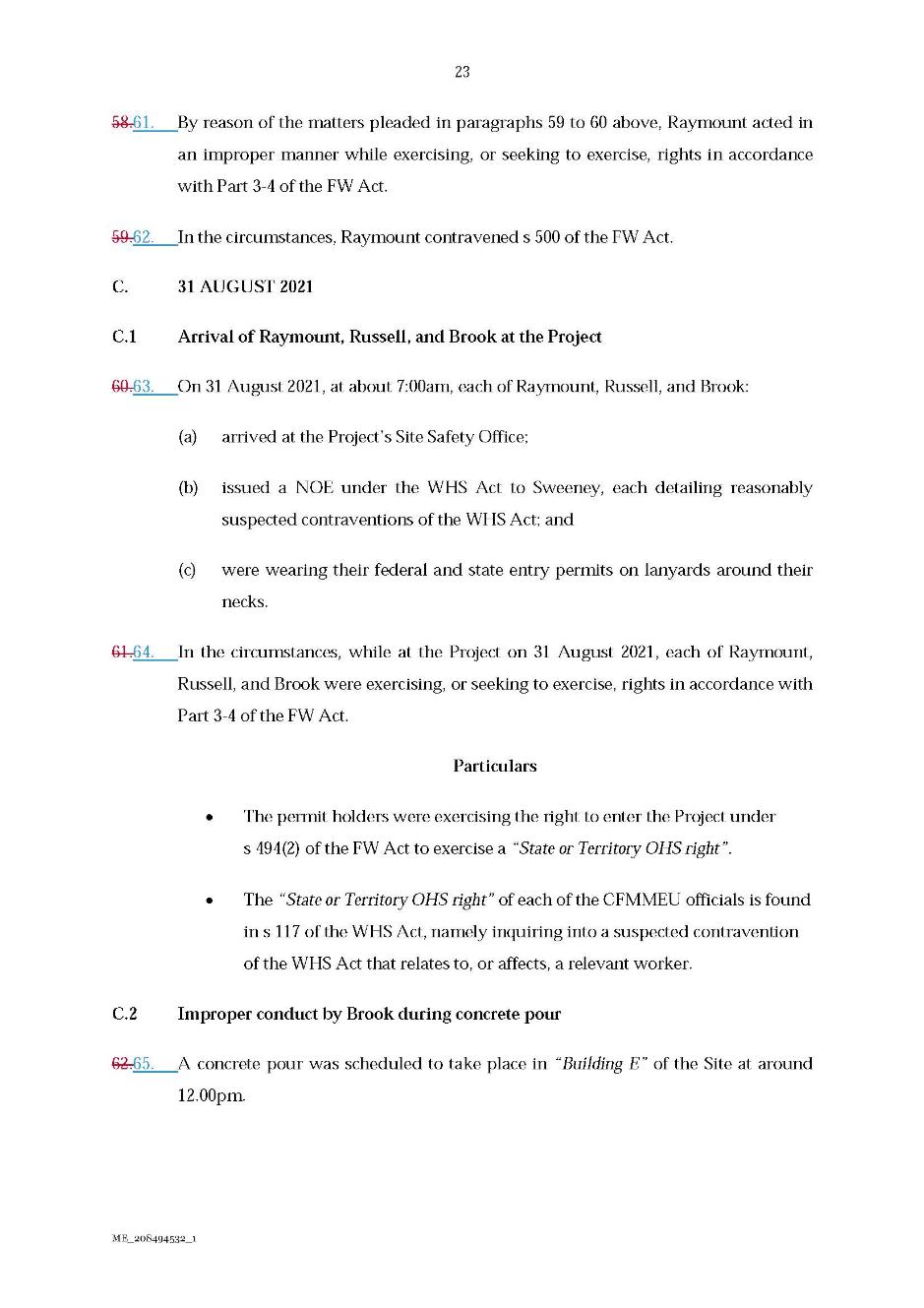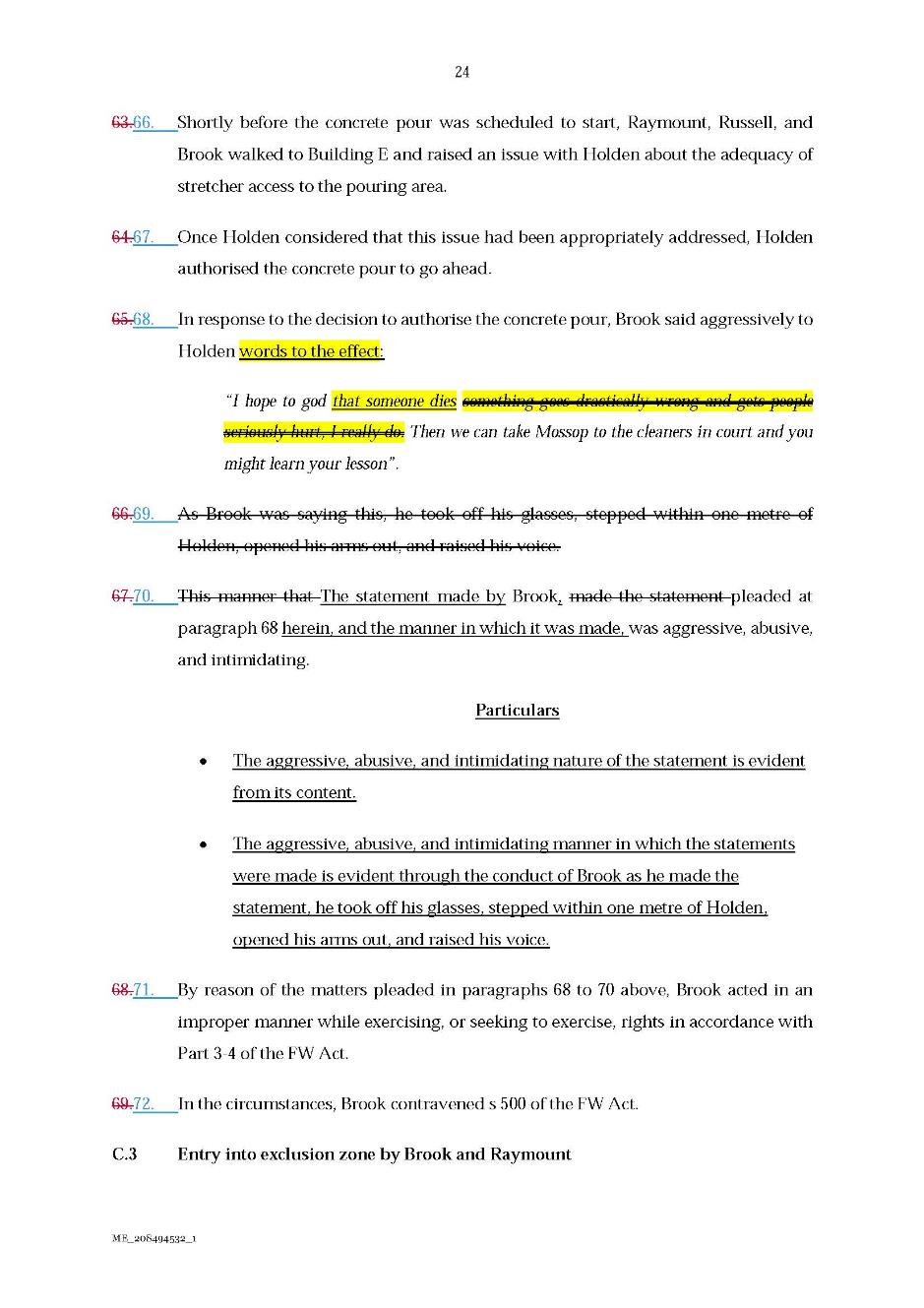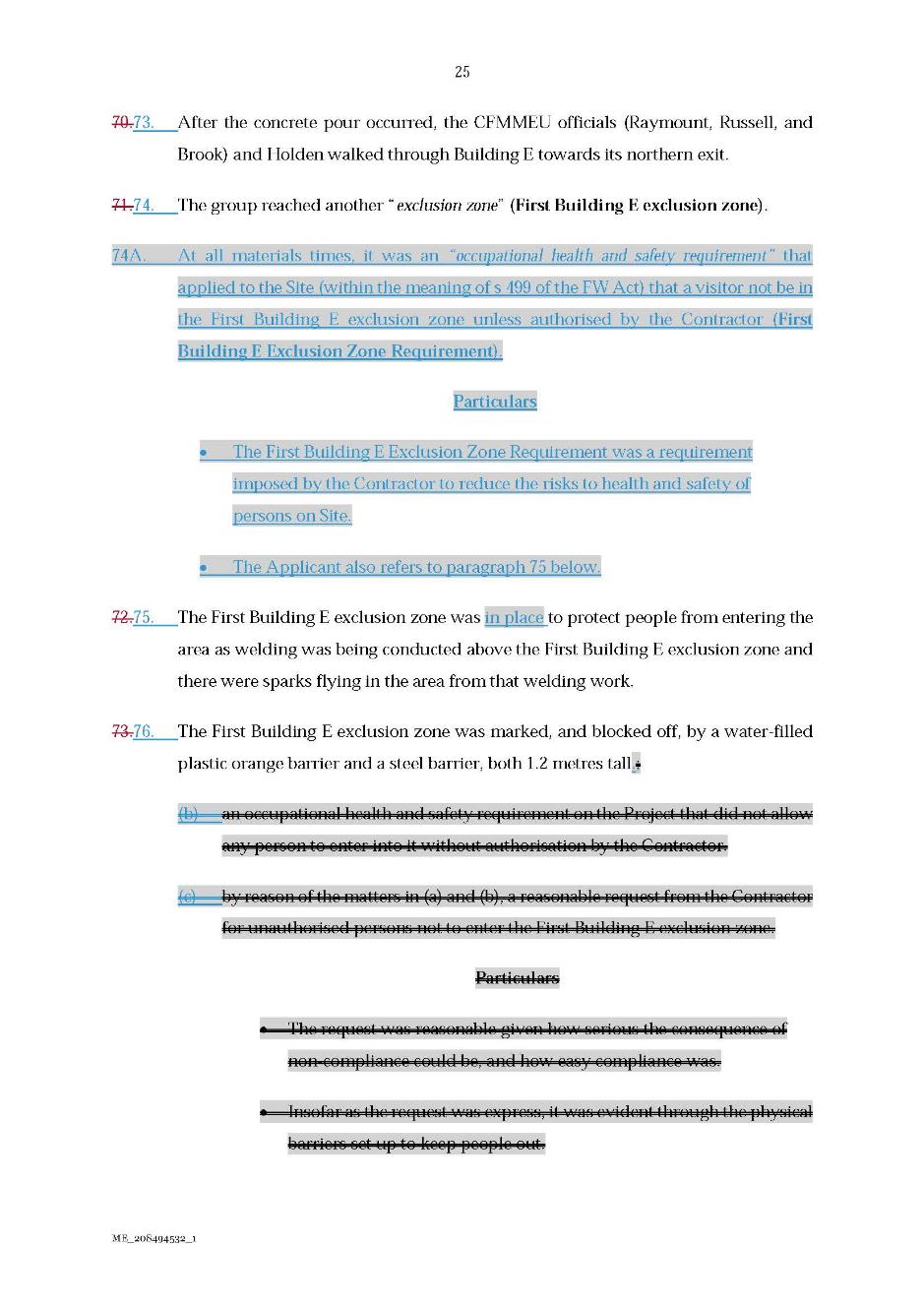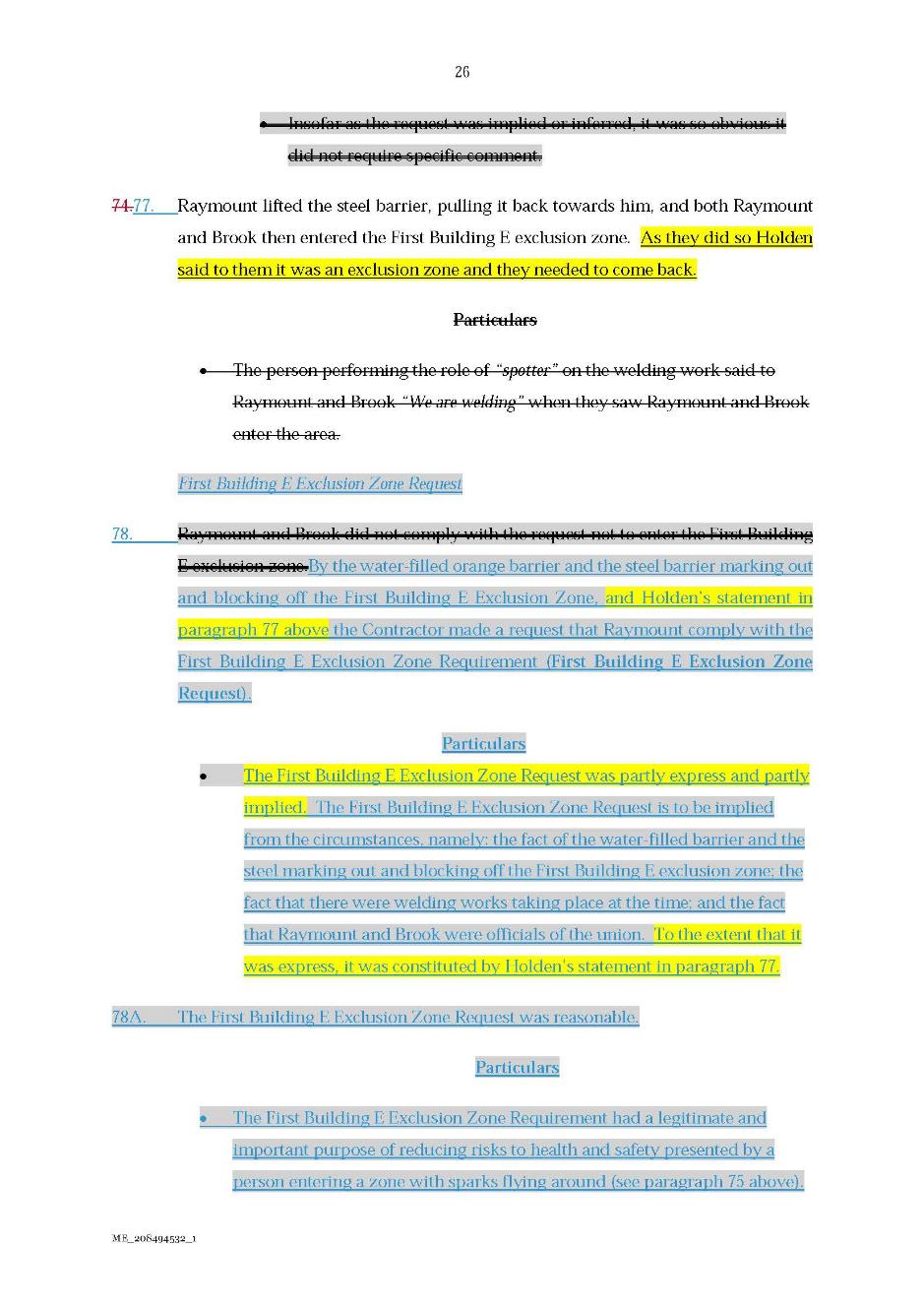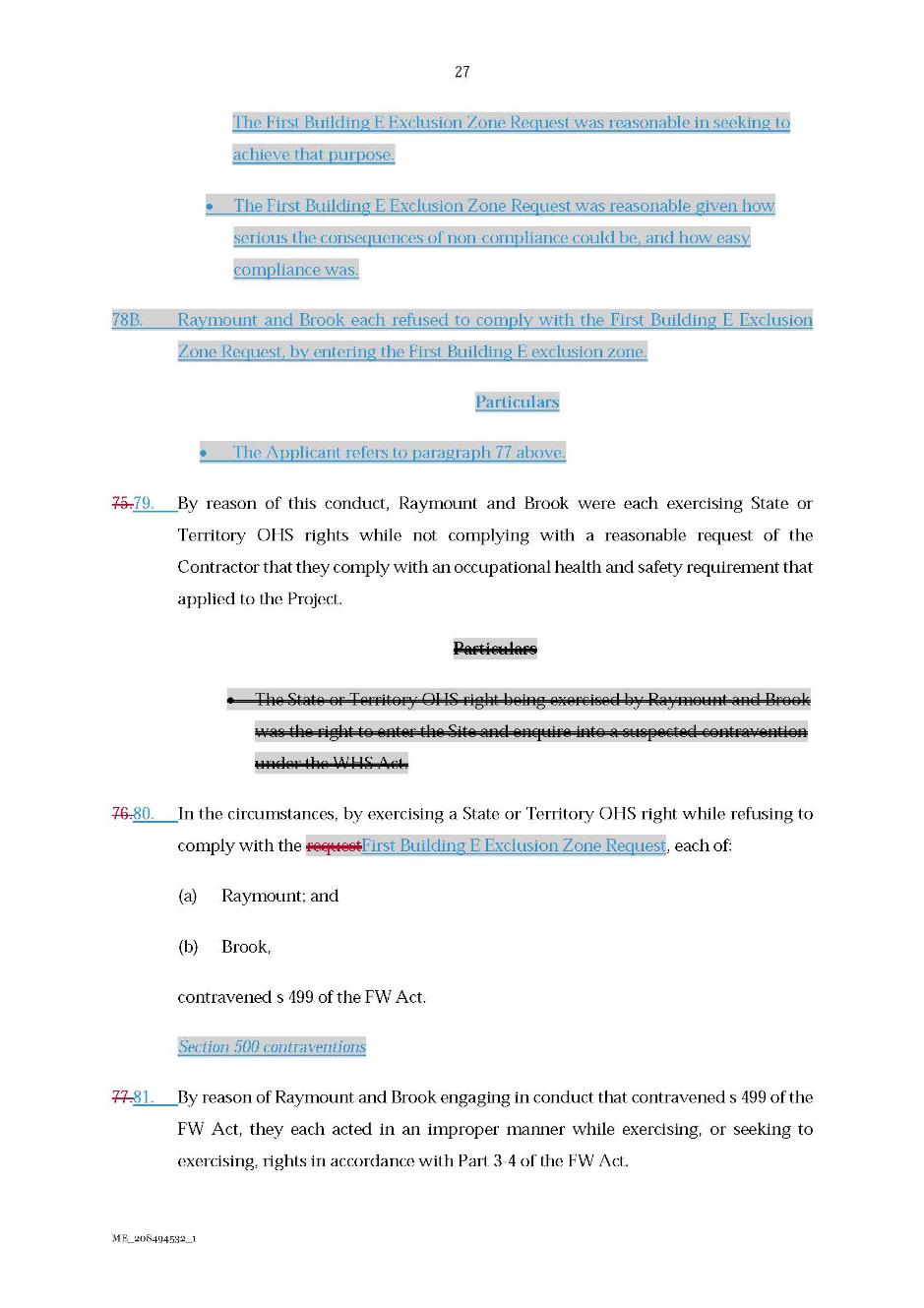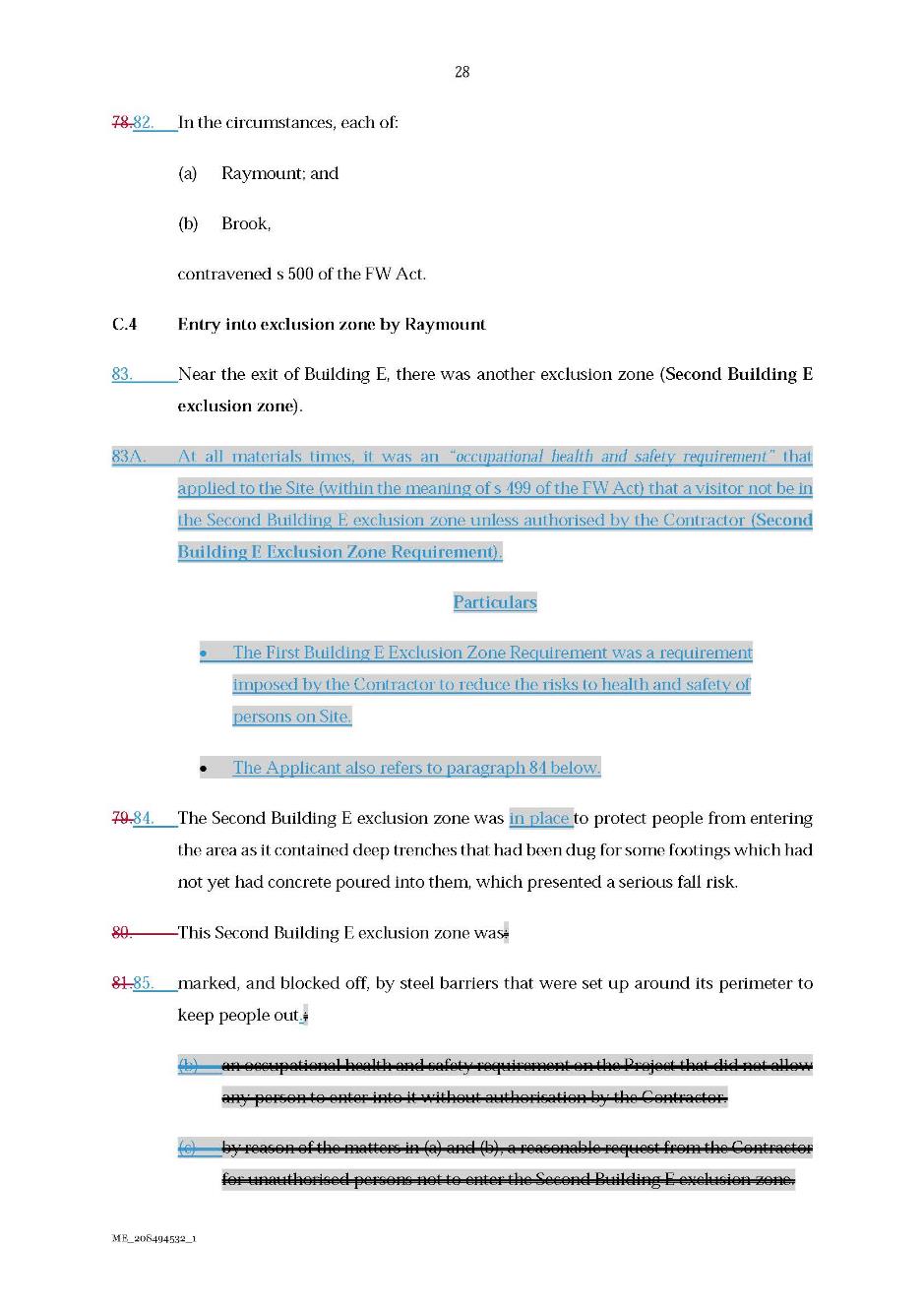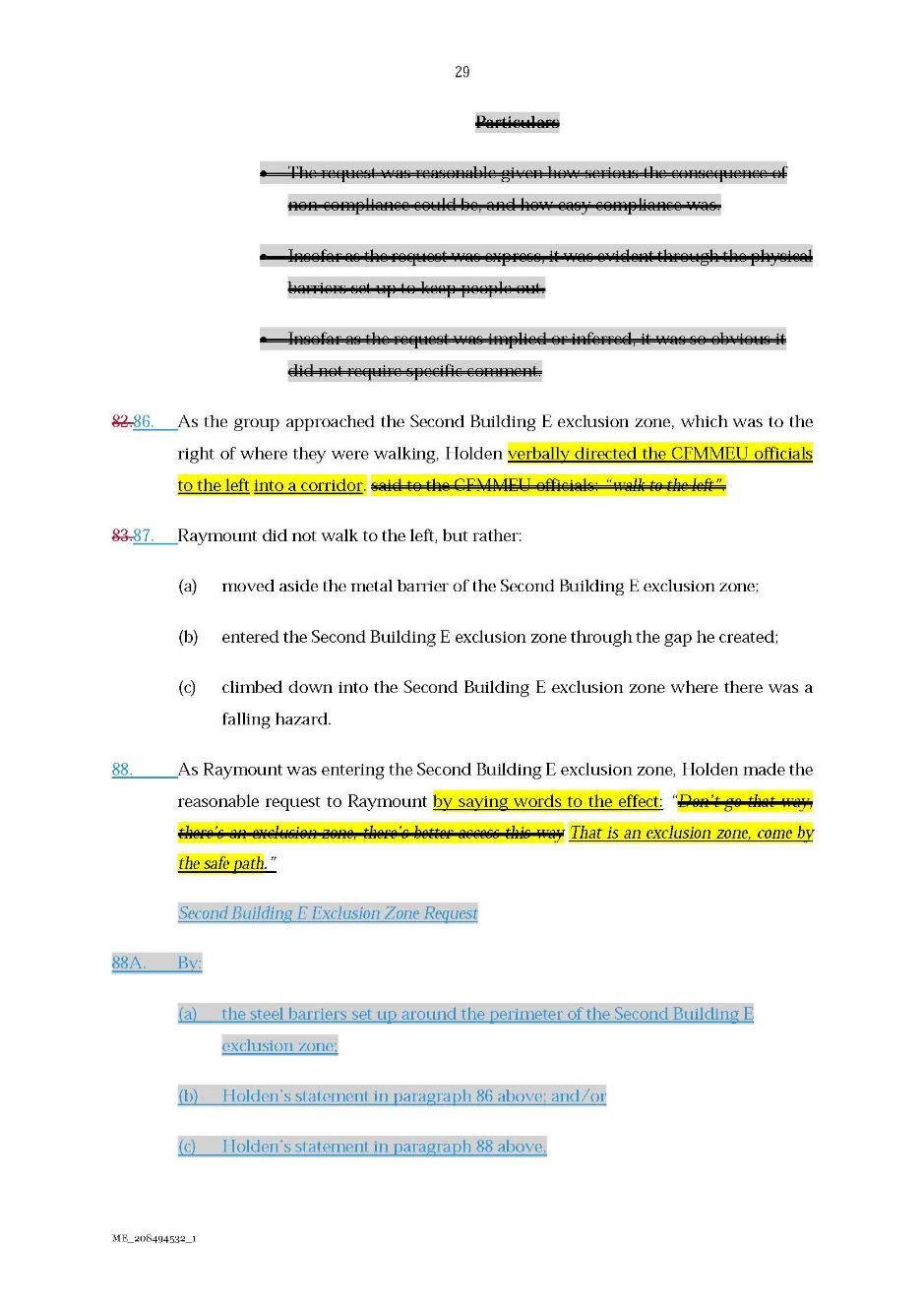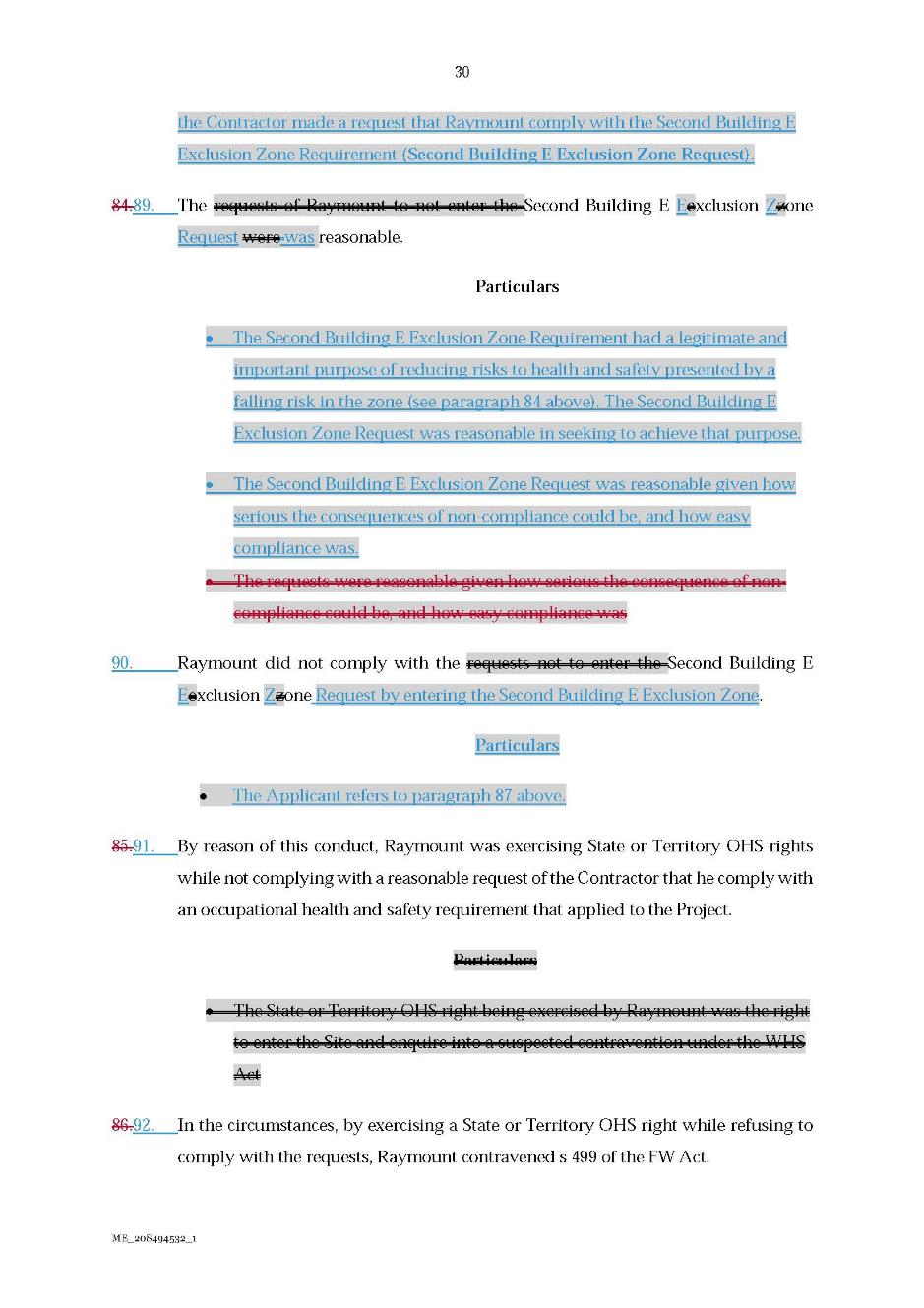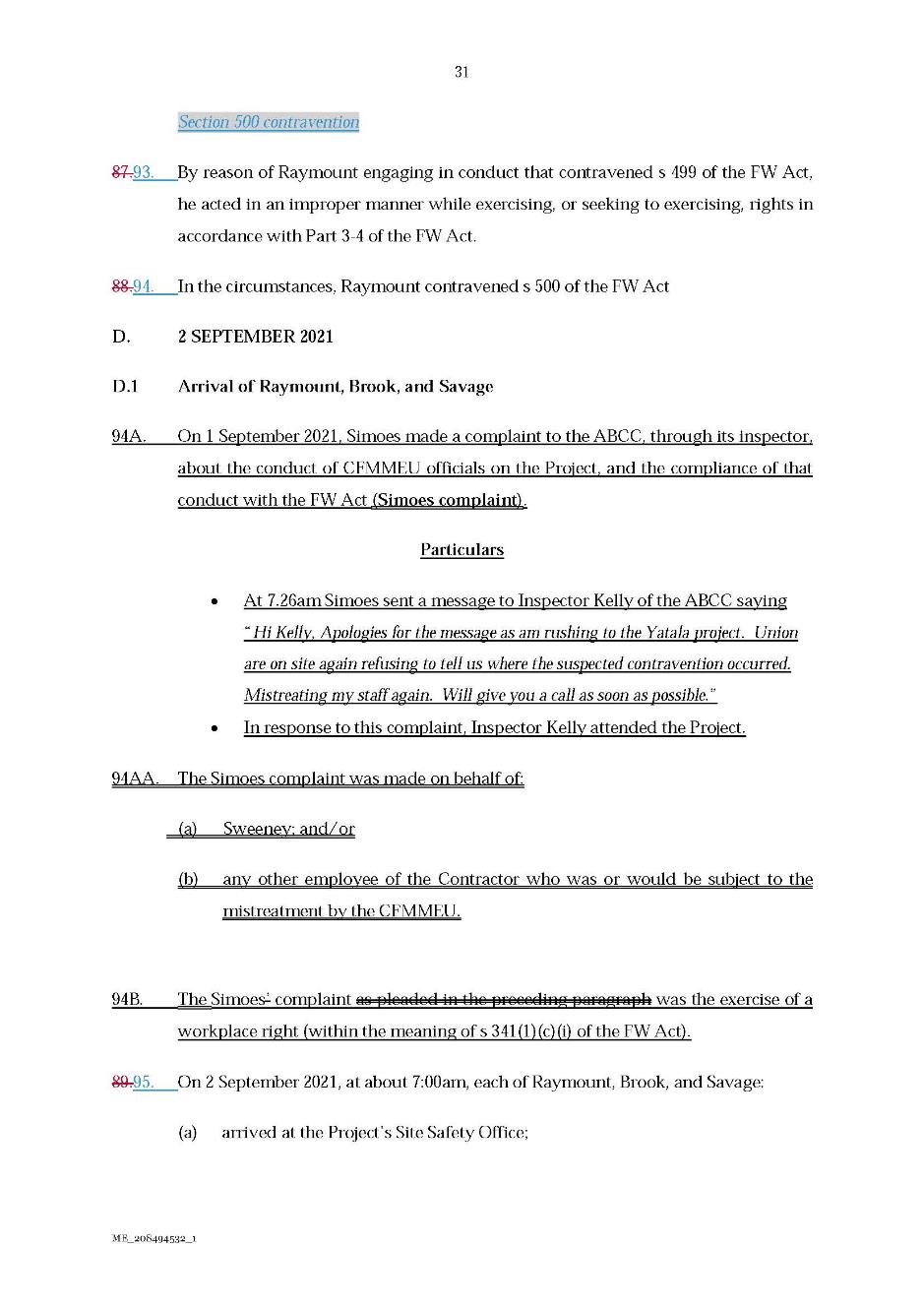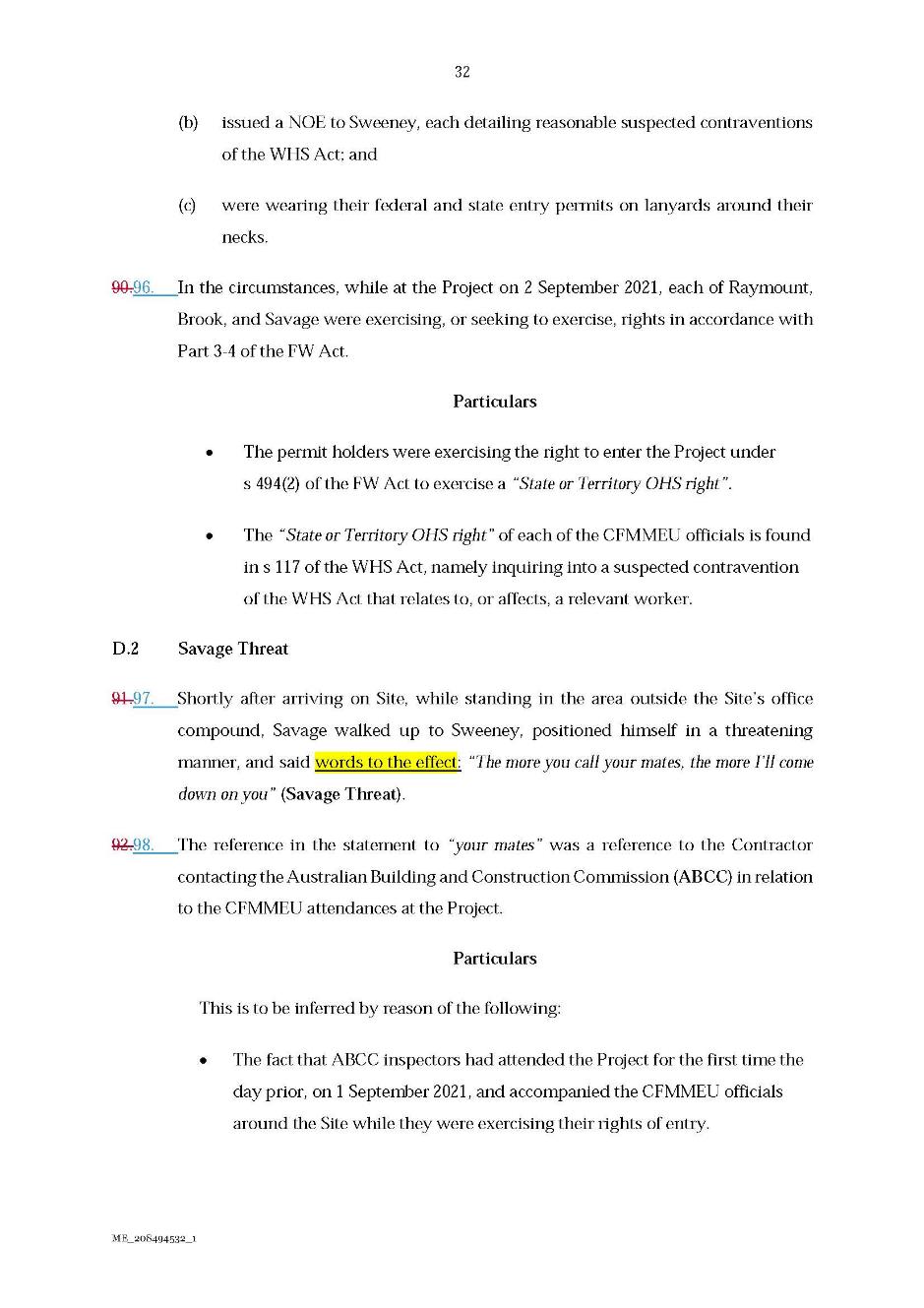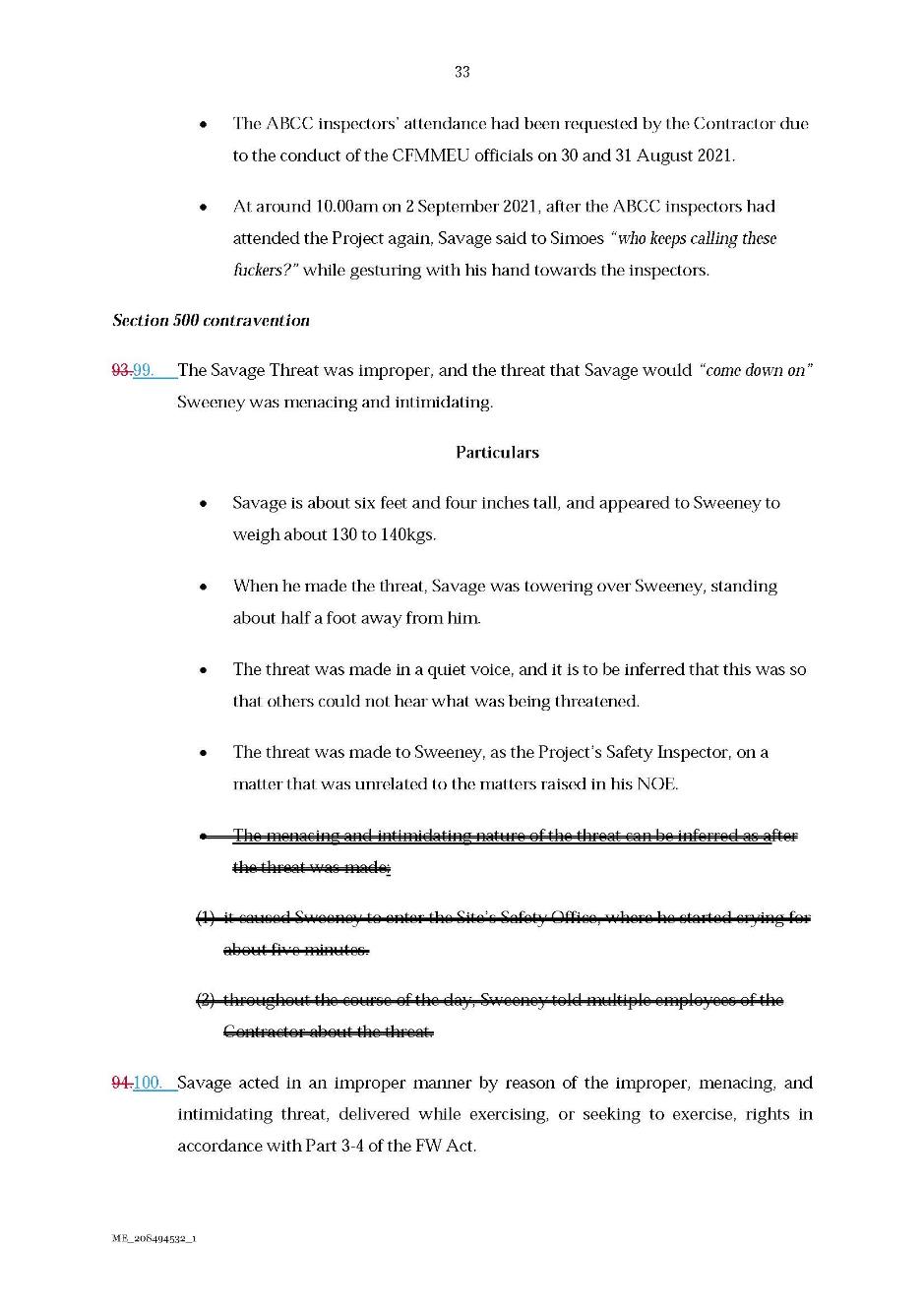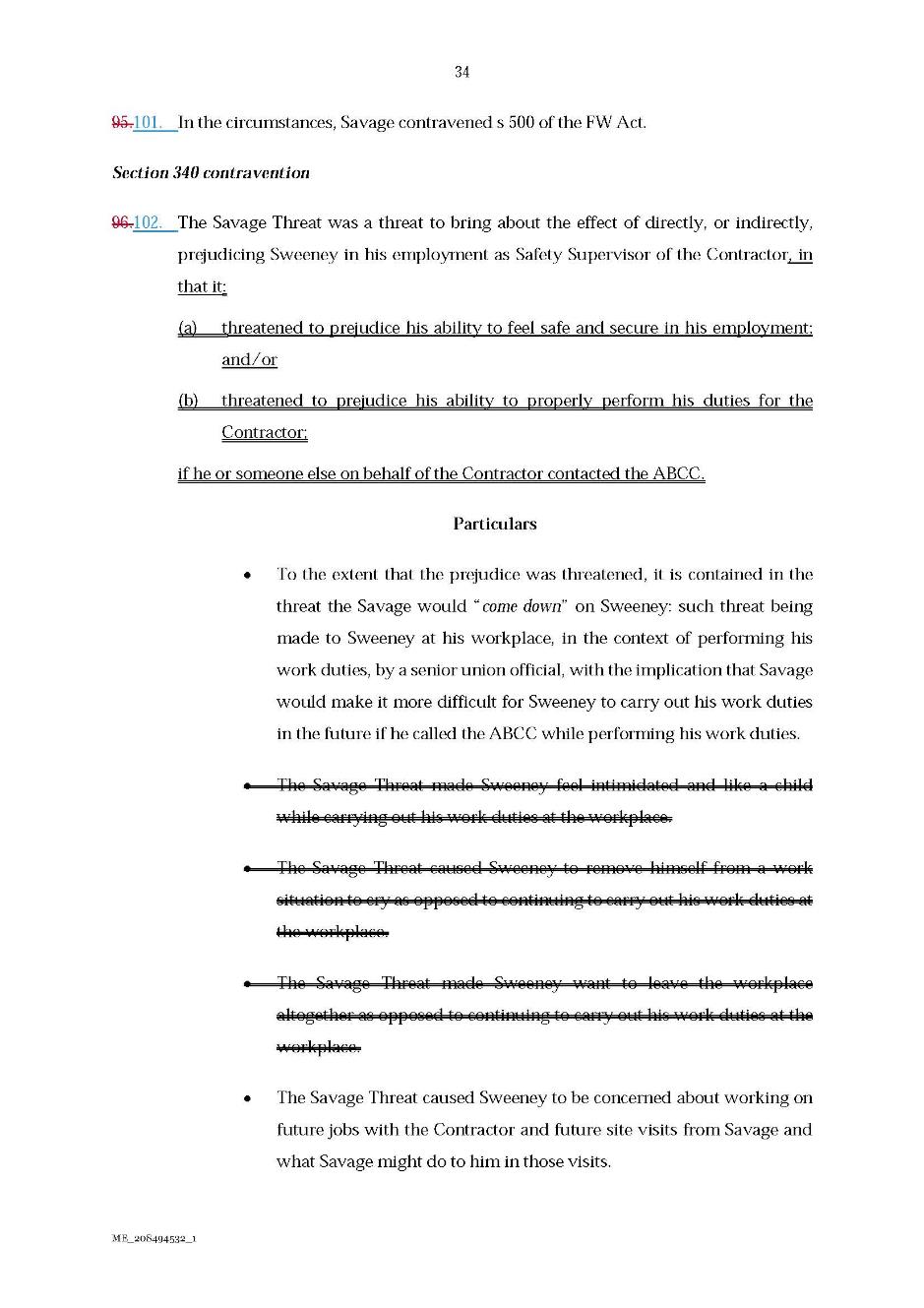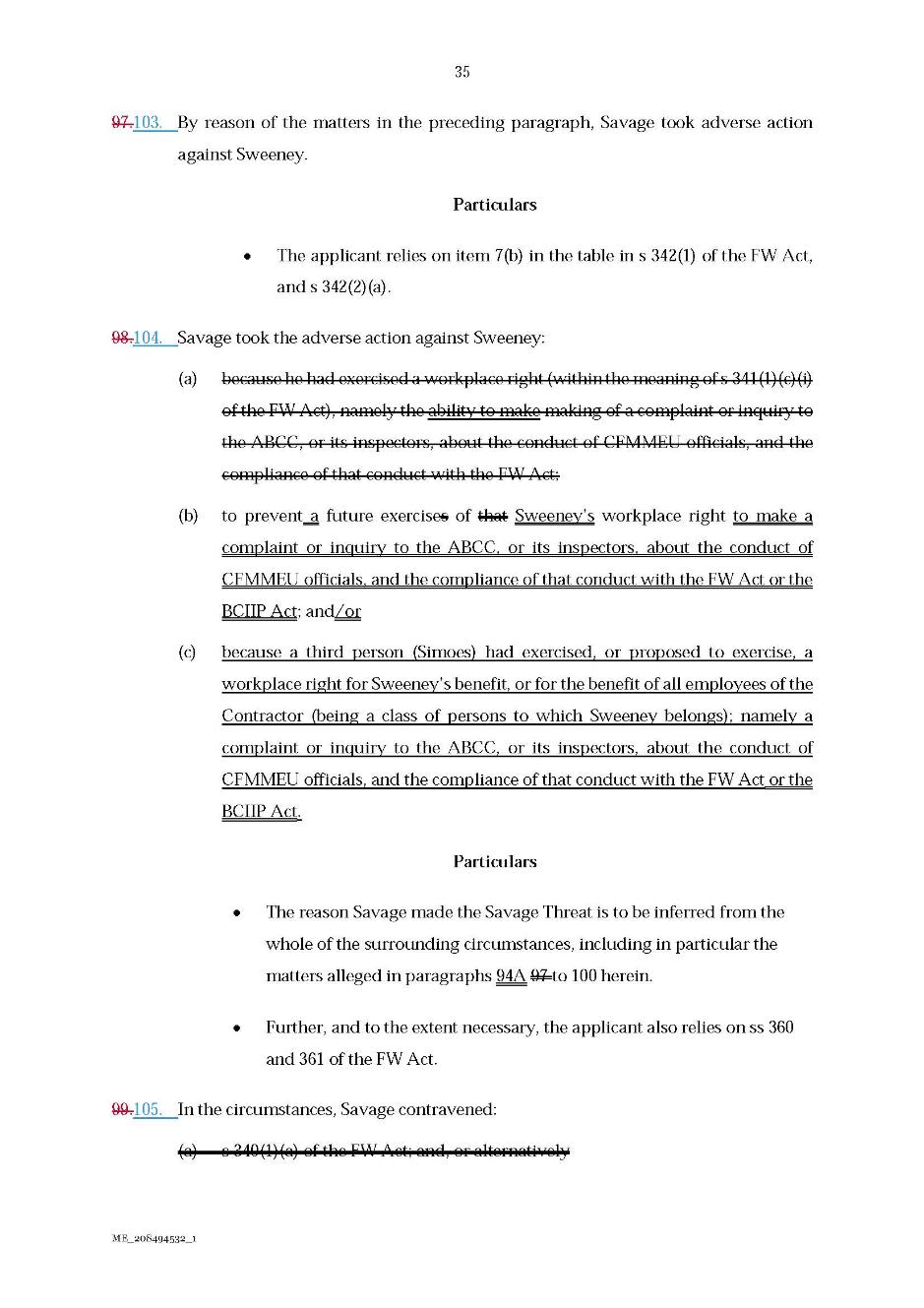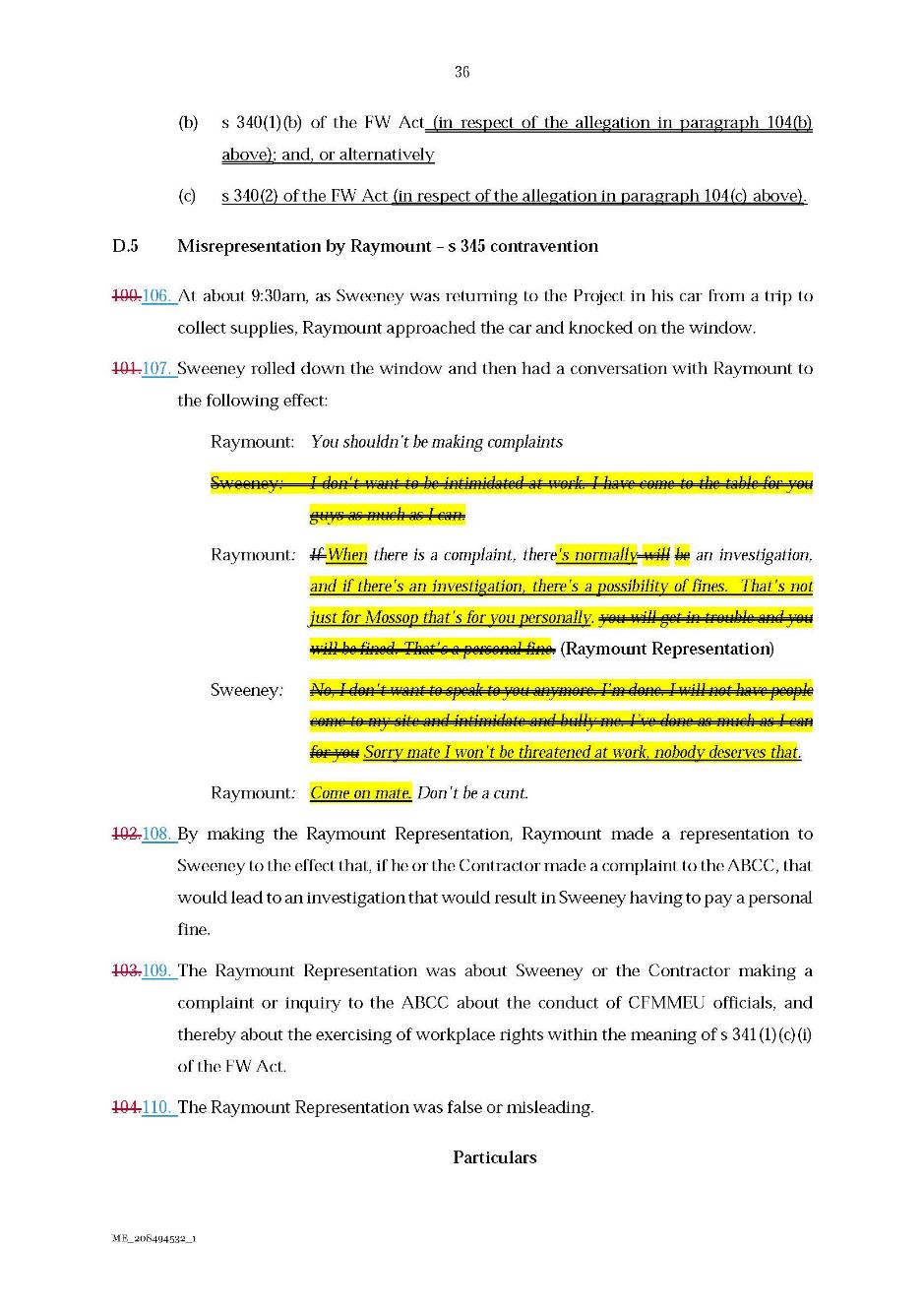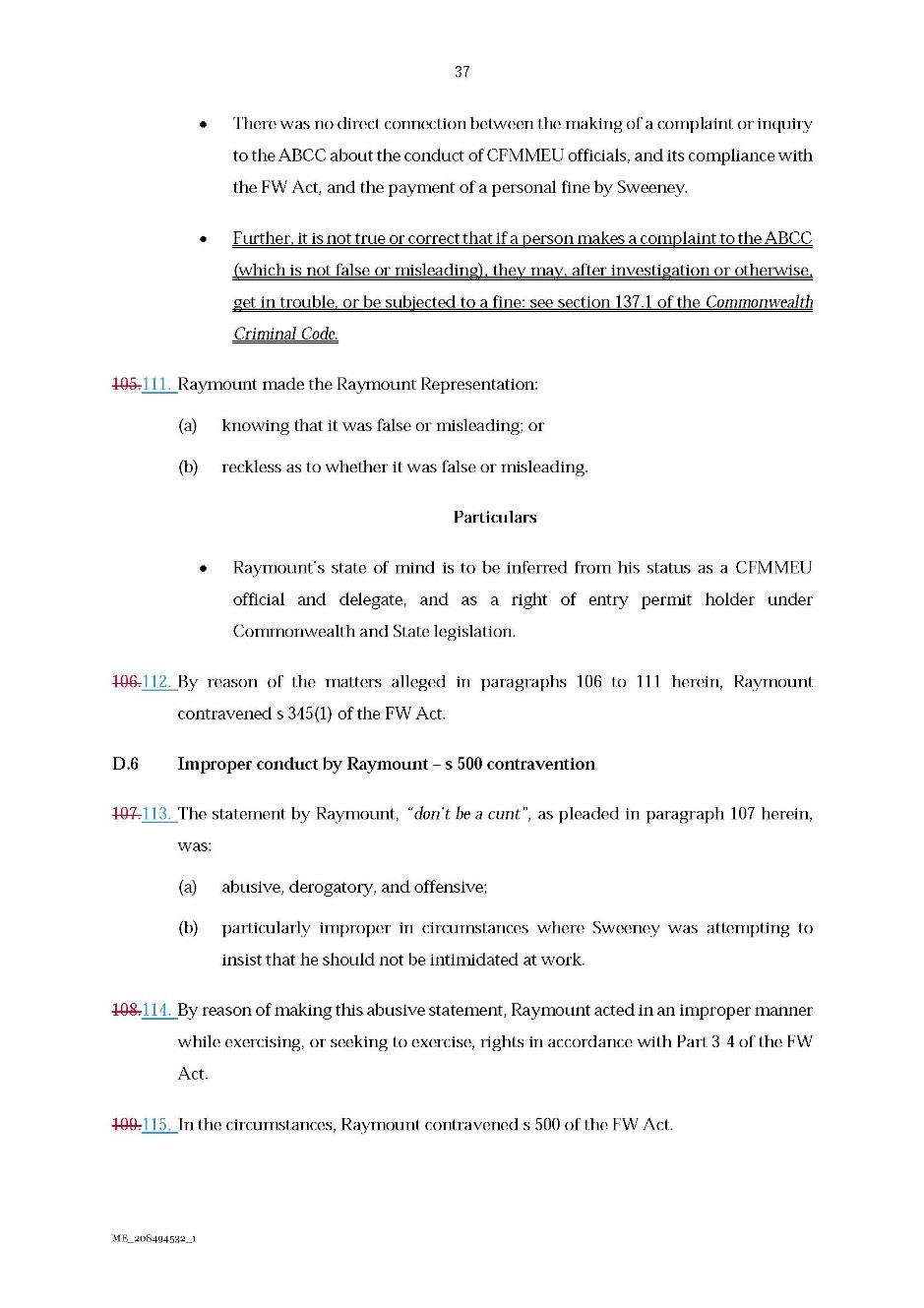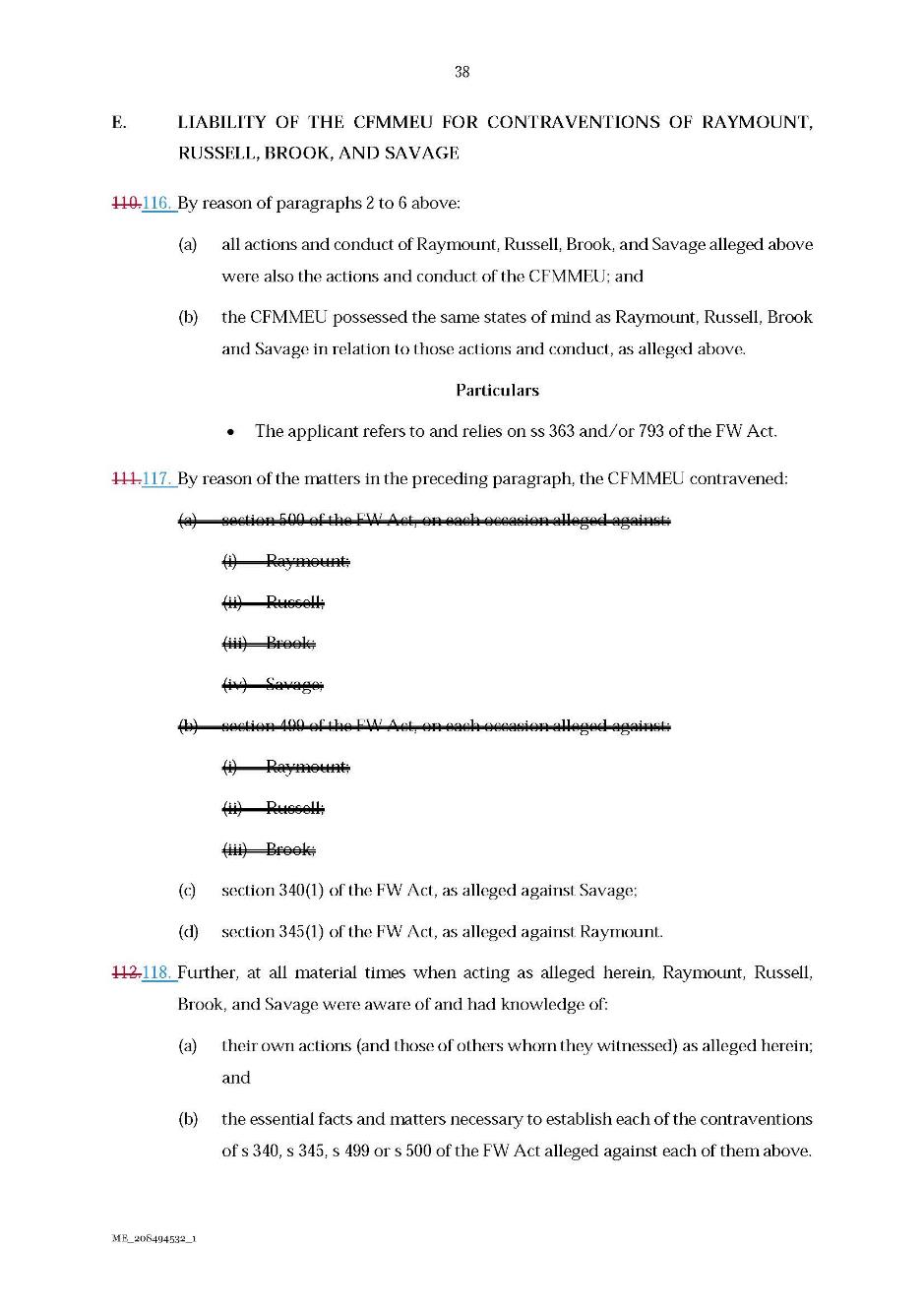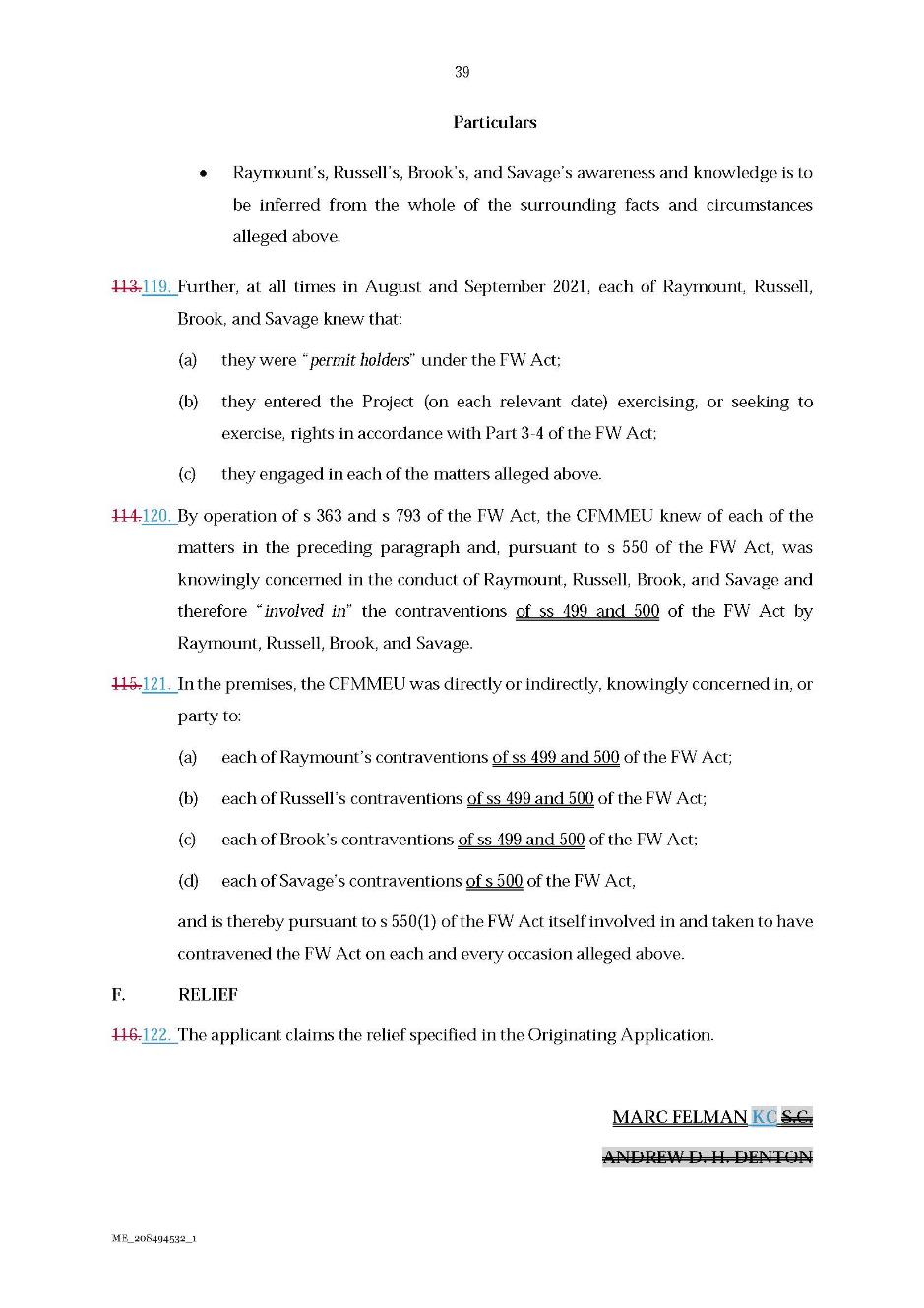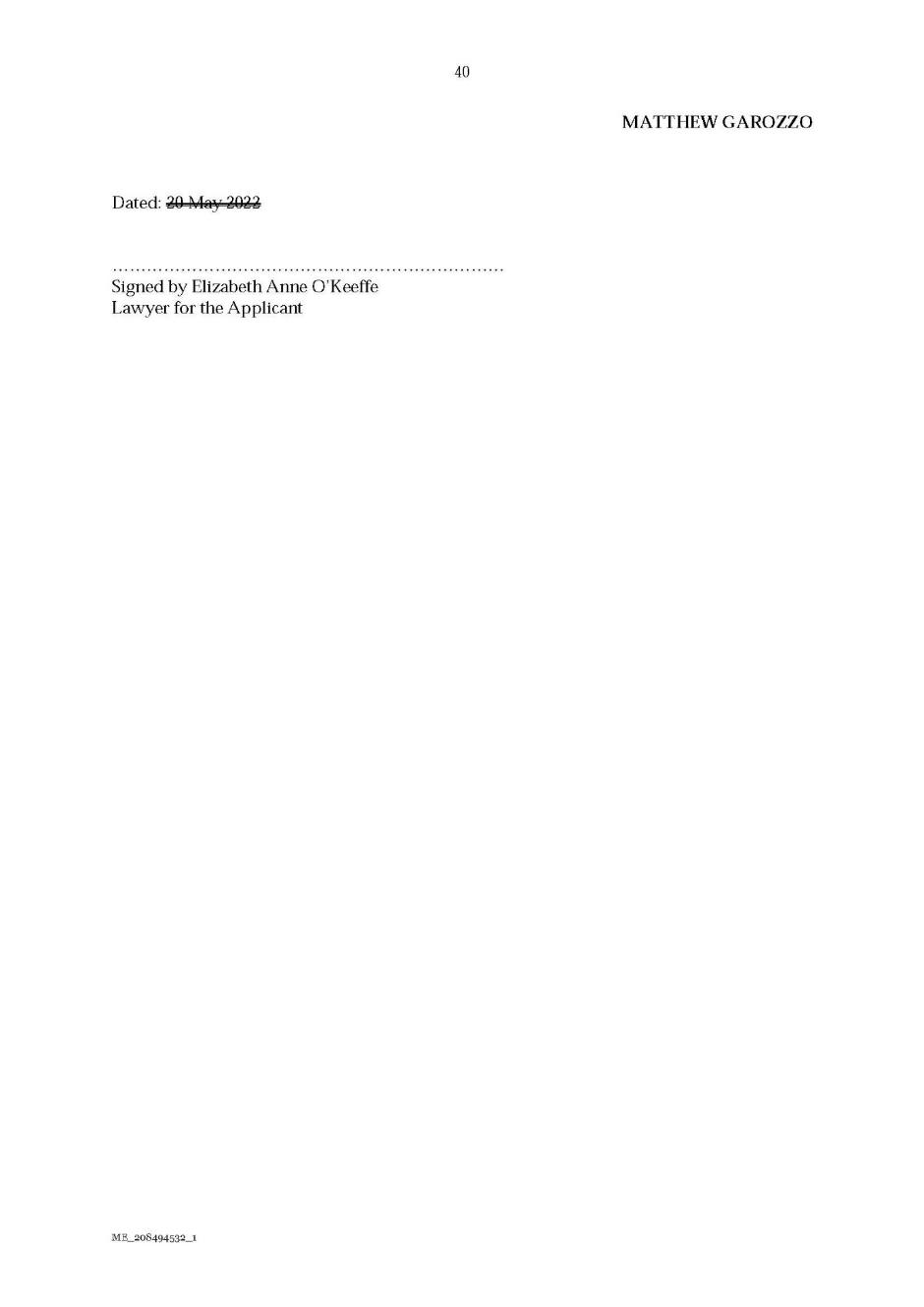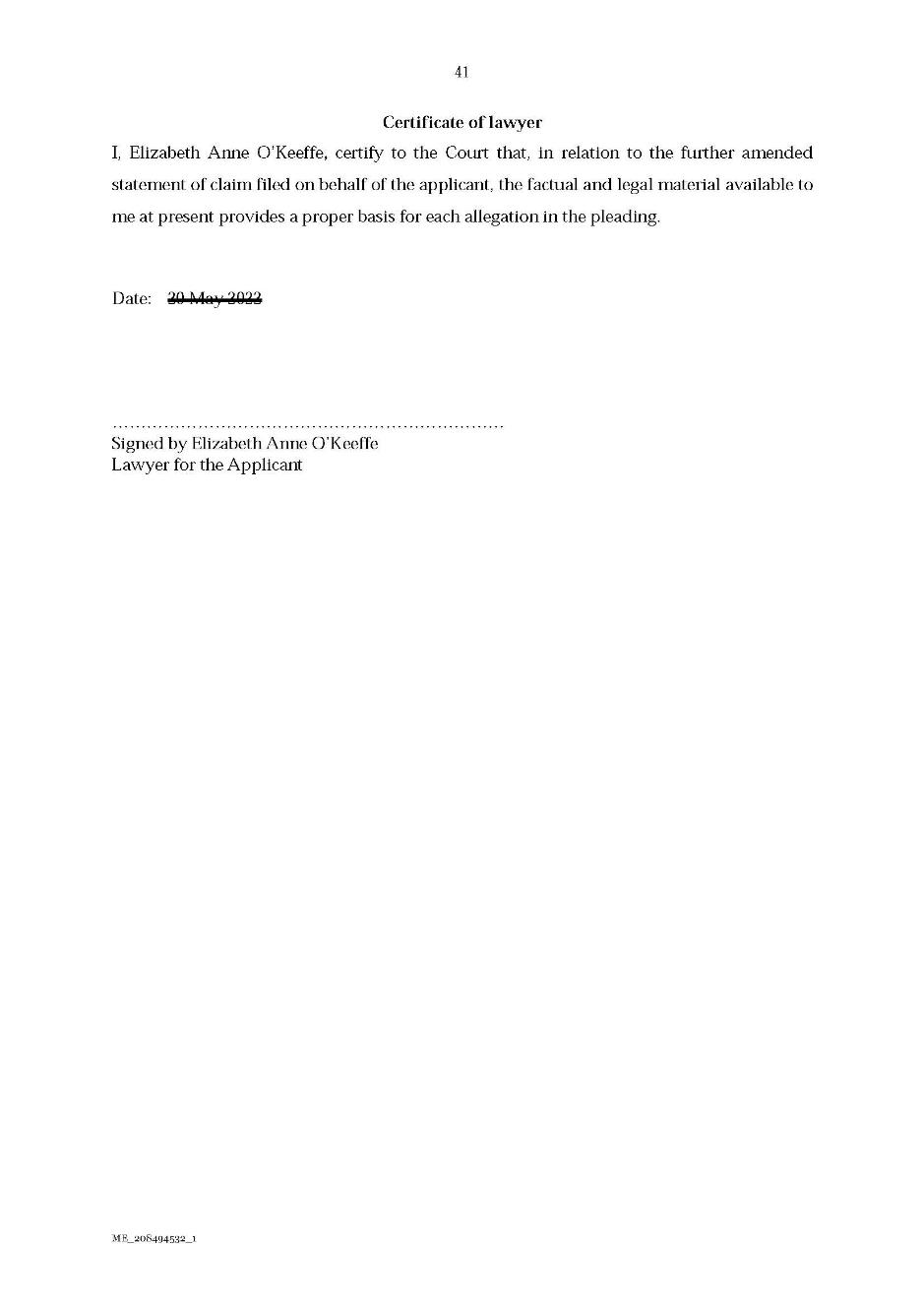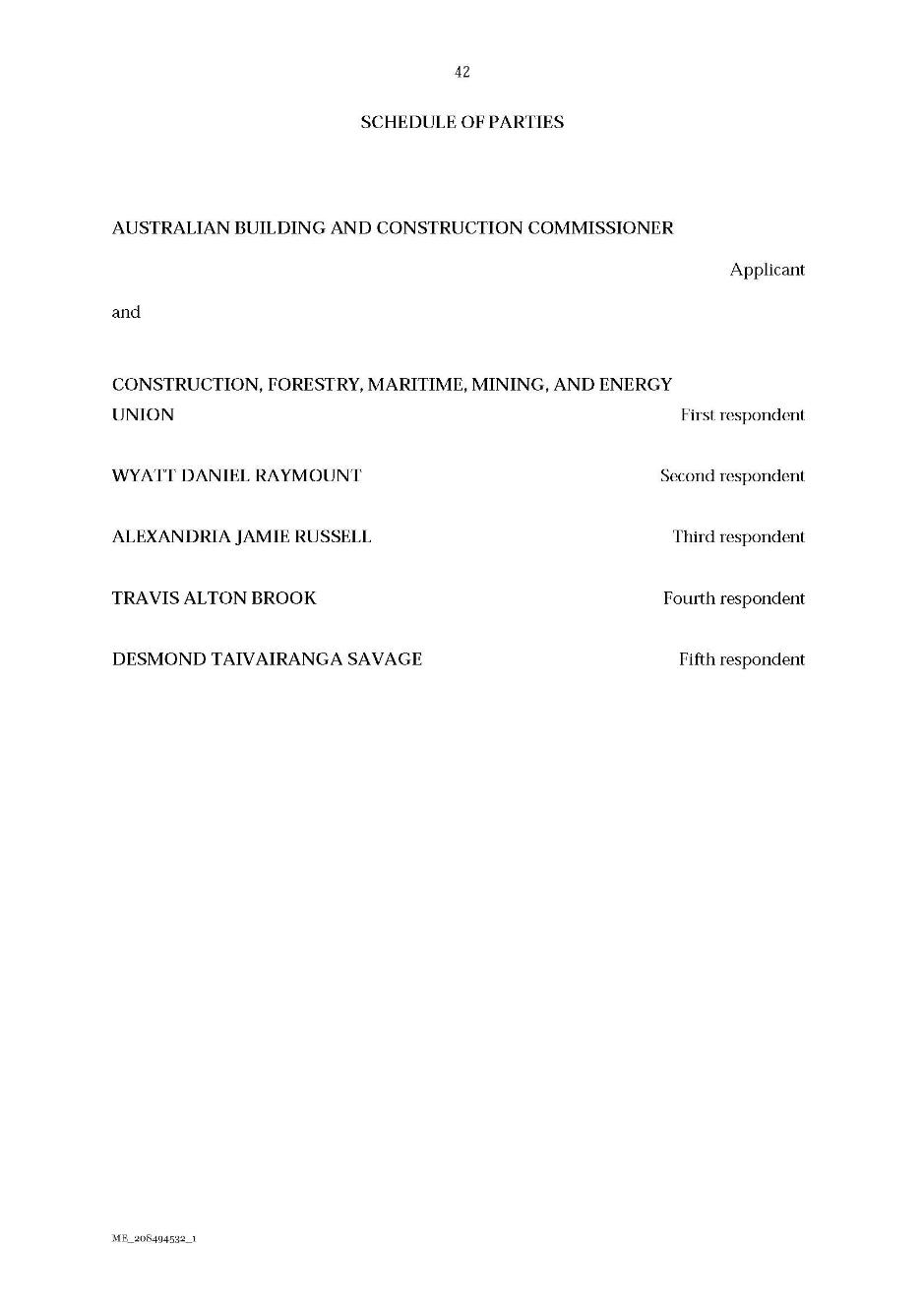Federal Court of Australia
Fair Work Ombudsman v Construction, Forestry, Maritime, Mining and Energy Union (The Yatala Labour Prison Case) (No 2) [2023] FCA 429
ORDERS
Applicant | ||
AND: | CONSTRUCTION, FORESTRY, MARITIME, MINING AND ENERGY UNION First Respondent WYATT DANIEL RAYMOUNT Second Respondent ALEXANDRIA JAMIE RUSSELL (and others named in the Schedule) Third Respondent | |
DATE OF ORDER: |
THE COURT ORDERS THAT:
1. The applicant has leave to file an amended originating application in the form provided to the Court on 4 April 2023.
2. The applicant has leave to file a third further amended statement of claim in the form provided to the Court on 4 April 2023.
Note: Entry of orders is dealt with in Rule 39.32 of the Federal Court Rules 2011.
O’SULLIVAN J:
1 The sole issue on this application is whether the applicant should be granted leave to file a third amended statement of claim and an amended originating application.
2 The matter is part-heard. It involves alleged contraventions of the Fair Work Act 2009 (Cth) by the respondents.
3 At the close of the applicant’s case, the applicant applied orally for leave to amend its second further amended statement of claim filed 17 February 2023 and its originating application filed 10 January 2022. The amendments are set out in two documents titled third further amended statement of claim and amended originating application respectively. Both documents were emailed to the Court on 4 April 2023 and are attached to these reasons at Schedule A.
4 It is for the reasons which follow, that the applicant is granted leave to file and serve an amended originating application and a third further amended statement of claim in the form proposed.
Principles
5 The principles applicable to an application to amend a pleading are not in dispute.
6 The Court’s discretionary powers in r 16.53 of the Federal Court Rules 2011 (Cth) (FCR) are broad and are to be exercised with regard to the overarching purpose set out in s 37M of the Federal Court of Australia Act 1976 (Cth): University of Sydney v ResMed Limited (No 5) [2012] FCA 232 at [14] (Stone J).
7 In Aon Risk Services Australia Ltd v Australian National University [2009] HCA 27; (2009) 239 CLR 175 at [96] (Gummow, Hayne, Crennan, Kiefel and Bell JJ) the High Court held that the question of further amendments to a party’s claim is dependent upon the exercise of the Court’s discretionary power, and at [102], that factors such as the nature and importance of the amendment to the party applying cannot be overlooked. It is the extent of the delay and the costs associated with it together with the prejudice which might reasonably be assumed to follow and that which is shown, which are to be weighed against the grant of permission to a party to alter its case. A relevant factor is the point the litigation has reached relative to a trial and an explanation will be required where there is delay in applying for amendment.
8 The onus is on the party seeking leave to amend to persuade the Court that such leave should be given: Dye v Commonwealth Securities Ltd (No 2) [2010] FCAFC 118 at [17] (Marshall, Rares and Flick JJ).
9 In Tamaya Resources Ltd (In Liq) v Deloitte Touche Tohmatsu [2015] FCA 1098, when considering the principles in Aon, Gleeson J identified relevant matters for consideration by the Court on an application to amend: at [127], [128].
(a) The nature and importance of the amendment to the party applying for it: Aon at [102];
(b) The extent of the delay and the costs associated with the amendment: Aon at [102];
(c) The prejudice that might be assumed to follow from the amendment, and that which is shown: Aon at [5], [100] and [102];
(d) The explanation for any delay in applying for that leave: Aon at [108];
(e) The parties’ choices to date in the litigation and the consequences of those choices: Aon at [112] and Luck v Chief Executive Officer of Centrelink [2015] FCAFC 75 at [44];
(f) The detriment to other litigants in the Court: Aon at [93], [95] and [114] and Luck at [44]; and
(g) Potential loss of public confidence in the legal system which can arise where a Court is seen to accede to applications made without adequate explanation or justification: Aon at [5], [24] and [30].
The weight to be given to the considerations identified in Aon, individually and in combination, and the outcome of the balancing process, may vary depending on the facts in the individual case: Cement Australia Pty Ltd v Australian Competition and Consumer Commission [2010] FCAFC 101; (2010) 187 FCR 261 at [51].
The respondents’ submissions and consideration
10 The respondents oppose the application on three bases:
(1) The application is advanced after the applicant has closed her case;
(2) The applicant has not provided a proper explanation for the delay in applying to amend, with the only explanation being that the amendments bring the pleadings into conformity with the evidence actually adduced at trial; and
(3) The respondents have adduced evidence of prejudice consequent upon the majority of the proposed amendments.
11 I deal with each of the proposed amendments later in these reasons, but it is convenient to consider some matters of general principle at this stage.
The application is advanced after the applicant has closed her case
12 At the close of its oral opening submissions, senior counsel for the applicant specifically identified the possibility that the oral evidence of some of the witnesses about exchanges that occurred 18 months ago may deviate “a bit from the pleading” and that “… depending on the level of deviation, we - I should flag that we will then rely on - depending on what the words are, we will rely on those words.”: Transcript, dated 20 March 2023, p 65, lines 44-46, p 66, line 1.
13 On that basis, the applicants submits that the respondents were on notice of the potential for an application to amend at the close of the applicant’s case. That, however, is not a complete answer to the application to amend.
14 The respondents referred to CFMEU v BHP Coal Pty Ltd [2015] FCAFC 25; (2015) 230 FCR 298 at [50]-[78] (Logan, Bromberg and Katzman JJ), in particular at [60], [63]-[65].
15 That matter concerned the publication and distribution of an overtime policy by the CFMEU at a coal mine. The policy was inconsistent with a more permissive overtime clause in an applicable enterprise bargaining agreement. BHP alleged a number of matters including that the CFMEU had “issued” an overtime policy which constituted adverse action against BHP and thereby amounted to a contravention of numerous provisions of the Act. The primary judge upheld BHP’s contentions.
16 The CFMEU contended as one of its grounds of appeal that the case had been conducted on a basis different from the pleaded case.
17 The Full Court allowed an appeal but not on that ground. When dealing with BHP’s pleadings the Full Court referred to s 551 of the Act which provides:
A court must apply the rules of evidence and procedure for civil matters when hearing proceedings relating to a contravention, or proposed contravention, of a civil remedy provision.
18 The Federal Court Rules 1979 (Cth) were the relevant rules at the time but for the purposes of this matter, nothing turns on that.
19 The CFMEU had submitted that the primary judge characterised erroneously the alleged contraventions as the promulgation of the overtime policy rather than the publication or dissemination of the “overtime policy document”. The question being considered was whether the overtime policy had been “issued” by the CFMEU sending it to new members and by displaying it on a noticeboard in the crib room. BHP had submitted that the case was conducted on the basis that the contraventions were not confined to the “issuing” of the documents in question and that the hearing had been conducted in a manner which was consistent with the way the case had been opened.
20 The Full Court noted the case as opened went beyond the pleading, that the primary judge had decided the case that BHP ran and the case had been run, as opened, without objection. Accordingly, the Full Court inferred that the CFMEU understood at the time that BHP’s case was the case it put in the opening submissions and the CFMEU was not prejudiced.
21 It is against that background that the passages upon which the respondents rely at [63]-[65] fall to be considered:
Even so, a civil suit for the recovery of a pecuniary penalty is a proceeding of a penal nature: Naismith v McGovern (1953) 90 CLR 336 at 341. In this class of case, it is especially important that those accused of a contravention know with some precision the case to be made against them. Procedural fairness demands no less. Furthermore, although the civil standard of proof applies, where (as here) the resolution of an issue exposes a respondent to a penalty, satisfaction on the balance of probabilities is not achieved by “inexact proofs, indefinite testimony, or indirect inferences”: Briginshaw v Briginshaw (1938) 60 CLR 336 at 362. The Evidence Act 1995 (Cth) now requires that the court take into account the nature of the cause of action in deciding whether it is satisfied that a party's case has been proved on the balance of probabilities: Evidence Act 1995 (Cth), s 140(2)(a) (“Evidence Act”).
Litigation is not a free for all. The overarching purpose of the civil practice and procedure provisions that apply in this Court is to facilitate the just resolution of disputes according to law and as quickly, inexpensively and efficiently as possible (Federal Court of Australia Act 1976 (Cth) (“FCA Act”), s 37M). It would not be just to decide a case on a different basis than the way it was conducted. Nor would it be just to permit an applicant to change the nature of its case after the evidence has closed and its weaknesses pointed out, at least not without a formal application and the grant of leave, on terms if necessary.
The long and the short of it, then, is that, in a civil proceeding of a penal nature, a statement of claim must allege a contravention known to law and with a sufficient statement of material facts to alert a respondent to the case to be met. Nevertheless, where an applicant's pleading is ambiguous but a respondent has nonetheless meaningfully engaged with it in its defence, that engagement and the manner in which an applicant's case is consequentially opened and the trial conducted and defended can and ought to be considered in deciding whether a respondent has suffered any procedural unfairness. That is so even if there has been no formal application to amend the pleading. The obligations imposed on the Court and the parties by Pt VB of the FCA Act do not lead to any different conclusion.
22 The Full Court dismissed the CFMEU’s ground of appeal based on the case being run differently to that which had been pleaded.
23 I do not consider BHP Coal assists the respondents. That is because, as will become apparent, amongst other reasons, the proposed amendments do not allege a case that is different in any material way from the case as pleaded when the applicant opened its case.
24 Questions of procedural unfairness or prejudice to the respondents carry great weight. Whether there is any procedural unfairness and whether the proposed amendments expose the respondents to any prejudice is a matter I consider below in relation to each of the proposed amendments. However, in the circumstances of this matter, the fact that the application was made at the close of the applicant’s case is not of itself a reason to refuse the application.
No proper explanation as to why the application is made at such a late stage
25 I have referred above to the statement by senior counsel at the close of the applicant’s opening submissions. That statement provides the explanation as to why the application to amend is made at this stage of the hearing.
26 In the main, this matter involves oral exchanges between the 2nd-5th respondents and various employees of the Head Contractor of Yatala Labour Prison, Mossop Group Pty Ltd. The allegations against the first respondent, the Construction, Foresty, Maritime, Mining and Energy Union (CFMMEU) (Union), rely on vicarious liability provisions within the Act.
27 The second further amended statement of claim pleads oral exchanges. During the course of the applicant’s case, the evidence of the applicant’s witnesses varied in some instances from that which was pleaded. It is not unusual for witnesses to give evidence of oral exchanges where the precise form of those oral exchanges varies from that which may have been the subject of the original instructions. That is a function of the effluxion of time and the witnesses’ memory.
28 I consider the explanation for the application to amend, so as to bring the pleadings into conformity with the evidence, to be a sufficient explanation in the circumstances of this matter.
29 The issue will be the extent of that variation and whether a materially different case is being advanced.
The respondents have adduced evidence of prejudice
30 The respondents read the affidavit of Jessica Margaret Dawson-Field, affirmed on 3 April 2023, as evidence of prejudice consequent upon the majority of the proposed amendments.
31 Ms Dawson-Field deposes that:
(a) At [20], the 2nd to 5th respondents have conducted the trial to date by reference to the existing pleadings and the statements of alleged material facts set out in the second further amended statement of claim;
(b) At [21], counsel have conducted the trial to date based on the instructions from the 2nd to 5th respondents in respect of those alleged material facts; and
(c) At [22]-[30], that decisions about the scope of cross-examination of the applicant’s witnesses were made by reference to the content of their evidence in chief considered in light of material facts pleaded in the relevant paragraphs which relate to those witnesses.
32 A number of points may be made about that submission. First, each of the witnesses gave oral evidence in chief. As I understand the submission arising from Ms Dawson-Field’s affidavit, the respondents’ written submissions and the oral submissions advanced by counsel for the respondents, to the extent the evidence in chief of those witnesses as to oral exchanges with the relevant respondents differed from that which was pleaded, a forensic decision was made by counsel not to cross-examine on the differences. A forensic decision, per se, is not an answer to all things the opposing party may do. Any forensic decision must be seen in context and as I have noted, questions of whether there is any procedural unfairness or prejudice arising will carry significant weight.
33 Second, by agreement between the parties, evidence of the applicant’s witnesses was not the subject of detailed witness statements but outlines of evidence. When evidence of conversations was led in chief from the applicant’s witnesses, it was not the subject of objection on the basis it was advancing a case different to that which was pleaded or was contained in the outlines of evidence. That consideration is only of limited weight.
34 Third, it was open to counsel to cross-examine on any differences between the evidence given by a witness as to the oral exchange with the relevant respondents and what was pleaded in the (then current) second further amended statement of claim. To the extent counsel made the forensic decision not to do so, even if the proposed amendments are allowed, it remains open to the respondents, if so advised, to point to any inconsistencies between the evidence of the applicant’s witnesses and the second further amended statement of claim as going to the reliability of the applicant’s witnesses. Whether that submission is accepted, of course, is another question. It is also open to the respondents to apply to have a witness recalled, noting that any such application may or may not be granted.
35 Accordingly, I do not consider the respondents have adduced evidence of prejudice by reason of the matters to which Ms Dawson-Field deposes in her affidavit. I will however, consider each submission as to any alleged procedural unfairness and/or prejudice suffered by the respondents consequent upon the forensic decision of counsel not to cross-examine or a particular point, as well as generally, when I consider each of the proposed amendments.
36 Next, in its written opening submissions, the first respondent submitted: at [7], that the applicant should not be permitted to add to or depart from its pleaded case and that the respondents opposed any deviation by the applicant from the pleaded case. The first respondent cites as authority: Australian Building and Construction Commissioner v Hall [2018] FCAFC 83; (2018) 261 FCR 347 at [49]-[50] (Tracey, Reeves and Bromwich JJ).
37 In response to the application to amend, the respondents submit that the proposed amendments are such that the respondents now face a very different case from the case pleaded at the commencement of trial and during the examination and cross-examination of the applicant’s witnesses.
38 I deal with the submission that the respondents face a “very different case” from that pleaded when the hearing commenced below when considering the proposed amendments, however first it is necessary to say something about Hall.
39 That matter involved the interaction between ss 360 and 361 of the Act. The relevant parts of ss 360 and 361 provide:
360 For the purposes of this Part, a person takes action for a particular reason if the reasons for the action include that reason.
361 (1) if:
(a) in an application in relation to a contravention of this Part, it is alleged that a person took, or is taking, action for a particular reason or with a particular intent; and
(b) taking that action for that reason or that intent would constitute a contravention of this Part;
it is presumed that the action was, or is being, taken for that reason or with that intent, unless the person proves otherwise.
40 The Commissioner had bought proceedings against Mr Hall and seven others, all of whom were organisers or employees of the then Construction, Forestry, Mining and Energy Union, alleging contraventions of Part 3-1 of the Act, in particular ss 340, 343 and 355. In so doing, the Commissioner relied upon the presumption in s 361. The primary judge dismissed the Commissioner’s originating application and on appeal, one of the grounds of appeal was the primary judge’s treatment of ss 360 and 361.
41 The Full Court noted that before the presumption in s 361(1) could operate, two preconditions had to be met. The first is in s 361(1)(a), whereby the particular reason or the particular intent for the contravening conduct must be alleged in the application such that an allegation under that section must precisely and distinctly identify the alleged reason, or the alleged intent, for the contravening conduct. The second is in s 361(1)(b), which is that taking the alleged action for the alleged reason or with the alleged intent identified in s 361(1)(a) (or both) would constitute a contravention of that part of the Act: Hall at [14]-[15].
42 The Full Court considered the primary judge’s assessment of the evidence of various witnesses called by the Commissioner and the evidence of the respondents, insofar as that evidence was directed to the reason, or reasons why Mr Hall and other respondents took the alleged action. The Full Court noted that a number of the allegations in the Commissioner’s amended statement of claim did not satisfy the second precondition in s 361(1) in that some of the allegations did not precisely and distinctly allege any particular reason or any particular intent.
43 At [49]-[50], after referring to the principle that one of the main purposes of pleadings is to define the issues in dispute with sufficient clarity to enable the opposite party to understand the case he or she has to meet and to provide him or her with an adequate opportunity to prepare to meet that case, the Full Court observed:
… A concomitant of this principle is that a party is not entitled to depart from his or her pleaded case except if the parties have both deliberately chosen to conduct the dispute on a different basis. That principle was expressed in Banque Commerciale SA (in liq) v Akhil Holdings Ltd (1990) 169 CLR 279 at 286-287 in the joint judgment of Mason CJ and Gaudron J as follows:
The function of pleadings is to state with sufficient clarity the case that must be met: Gould and Birbeck and Bacon v Mount Oxide Mines Ltd (In Liquidation) [(1916) 22 CLR 490], per Isaacs and Rich JJ at 517. In this way, pleadings serve to ensure the basic requirement of procedural fairness that a party should have the opportunity of meeting the case against him or her and, incidentally, to define the issues for decision. The rule that, in general, relief is confined to that available on the pleadings secures a party’s right to this basic requirement of procedural fairness. Accordingly, the circumstances in which a case may be decided on a basis different from that disclosed by the pleadings are limited to those in which the parties have deliberately chosen some different basis for the determination of their respective rights and liabilities. See, e.g., Browne v Dunn [(1893) 6 R 76]; Mount Oxide Mines [(1916) 22 CLR 490 at 517-518].
In our view, these observations apply with even more force in a proceeding such as this where declarations of contravention of the FWA were sought against the respondents and civil penalties were sought to be imposed on them.
Faced with those serious consequences, the respondents were entitled to be told clearly and precisely in the Commissioner’s ASOC what case it was they had to meet and, unless they deliberately chose to allow the case to be conducted on a different basis, to direct their evidence and arguments to that case and that case alone. Plainly, this latter exception did not permit the Commissioner to make a significant addition to, or departure from, the pleaded case, in counsel’s opening or closing submissions and then seek to justify that course by pointing to the respondents’ failure to object as evidence of their acquiescence in that course. If that were the test, this departure from the basic requirements of procedural fairness would not occur by the deliberate choice of the party entitled to fair notice but rather at the self-serving behest of his or her opponent. If such an approach were permitted, the requirement to give fair notice would be made redundant, trial by ambush would become a legitimate tactic, and the issues in dispute at trial would become a movable feast. As well, the ability of a trial judge to manage the trial to ensure it fairly addressed the issues in dispute would be significantly eroded, if not entirely destroyed. So, too, would be the capacity of the trial judge to identify the issues he or she needed to decide.
44 With respect to the respondents, their reliance on Hall in this matter is misconceived. The defining point in Hall was the satisfaction of the pre-conditions required before the presumption could operate. The fact there were civil penalties sought to be imposed in circumstances where the presumption operated, highlighted why it was that the respondents were entitled to be told the precise reason or the precise intent they were alleged to have had, such that the respondents could understand the case they had to meet. Absent that, in the particular circumstances of Hall and the prescriptive pre-conditions in s 361 of the Act, the respondents did not know the case they had to meet.
45 In contrast, the issues in this matter, save for one matter, do not involve the presumption in s 361 and the consequent reversal of the onus of proof because in none of the sections alleged to have been breached is there an allegation that any the respondents took action for a particular reason or with a particular intent and that action for that reason or with that intent would constitute a contravention of Part 3-1 of the Act.
46 Specifically:
(a) The allegations against Mr Raymount, Ms Russell, Mr Brook and Mr Savage for contraventions of s 500 of the Act relate to acting in an improper manner. That involves an objective assessment of their conduct;
(b) The allegations against Mr Raymount, Ms Russell and Mr Brook for contraventions of s 499 concern failure to comply with a reasonable request. That also involves an objective assessment of their conduct as well as an assessment of whether the request was reasonable; and
(c) The allegations against Mr Savage for taking adverse action against Mr Sweeney contrary to s 340 may involve the operation of the presumption in s 361, however the proposed amendment is not directed to any pleading of either of the s 361 pre-conditions.
47 Accordingly, I do not consider that Hall assists the respondents.
48 The respondents submit that they will be prejudiced if the applicant is permitted to amend its pleadings after the close of its case to conform with the evidence that has been adduced to date in circumstances where that evidence did not, at the time it was led and cross-examined upon, support the case pleaded against the respondents.
49 I will consider that submission when dealing with each of the proposed amendments.
50 As a separate but related point, the respondents submit that this is not a case in which the respondents have acquiesced in the manner in which the applicant has sought to conduct the trial and lead evidence in a manner different to the pleaded case. As I understand that submission, the respondents rely on the statement in [7] of the first respondent’s written opening submissions to which I have referred above.
51 A bare statement made in opening submissions such as in [7] of the first respondent’s opening submissions before any evidence is called does not necessarily result in a party not acquiescing in how a case is presented. Each case will depend on the particular circumstances. In any event, the respondents’ submission of non-acquiescence necessarily pre-supposes that the case being presented was different from that pleaded. I will consider that question when considering if the respondents will be accorded procedural fairness or will be prejudiced if the proposed amendments are allowed.
Federal Court Rules 2011 (Cth) (FCR) – r 16.04
52 Section 551 of the Act provides that a Court must apply the rules of evidence and procedure for civil matters when hearing proceedings relating to a contravention, or proposed contravention, of a civil remedy provision.
53 The respondents face a case of alleged contraventions of the Act which, if established, may lead to civil remedies in the form of civil penalties: s 539 of the Act.
54 FCR 16 deals with pleadings. FCR 16.04 provides:
(1) A pleading that refers to a document or spoken words need only state the effect of the document or words without including the terms of the document or the words themselves.
(2) However, if the words are material to the pleading, the pleading must include the words.
55 None of the parties referred to this rule on the application and I deal with it for completeness.
56 The rule is directed to the obligation to plead. It does not mean that if there is a difference between what is pleaded and the evidence given there is necessarily a material change to the case being faced by the opposing party. It will all depend on the particular factual circumstances being alleged and in the circumstances of this matter how that relates to the particular alleged contravention in question.
The proposed amendments
57 In considering each of the proposed amendments I do so by reference to the respondents’ written and oral submissions.
Paragraphs 13 to 21C
58 The applicant deletes and adds to [14] and [15]; deletes part of [16]; and deletes [18], [19A]-[21C] in their entirety. I do not understand there to be any objection to any of the deletions.
Paragraphs 14, 15 and 16
59 The amendments to these paragraphs fall into three categories.
60 The first is an amendment to the preamble to [14] and deletion of the preamble to [15]. The particulars to [15] remain largely unchanged and as proposed, provide the particulars to the preamble to [14]. To that extent, the case is no different from that which was alleged previously given that the locations identified in the particulars to [15] have not changed.
61 The second category of amendment is to the words alleged to have been spoken at sub- paragraphs 14(a) and (c). The words sought to be added reflect the evidence in chief of the applicant’s witnesses, Mr Sweeney and Mr Gesuato.
62 The respondents submit that they cross-examined Mr Gesuato to establish that no bad words or abusive comments were made in their presence at the relevant time and not at other times. That may be so, but the only evidence from Mr Gesuato concerned the words “you’re incompetent”: Transcript, dated 24 March 2023, p 363, lines 1-27. Once that evidence was given it was open to cross-examination. The forensic decision made by counsel is said to be that because the evidence did not match the pleading precisely, that there was no need to cross-examine.
63 However, once given without objection and without cross-examination, the consequence is that the only evidence from Mr Gesuato is unchallenged. That is a matter which counsel will need to address and in any event, it is open to the respondents to apply to have Mr Gesuato recalled. I add that the fact that Mr Gesuato’s evidence is unchallenged, does not mean that the evidence will necessarily be accepted. As I have noted above, if so advised, the respondents may submit that the differences between the evidence given by any of the applicant’s witnesses and the second further amended statement of claim are such that the applicant’s witnesses are not reliable and should not be accepted.
64 As to Mr Sweeney, the respondents submit that the amendments seek to change the statements allegedly addressed to him and the time at which those statements were made. In so far as the time is concerned, the allegations are unchanged and remain that the statements were made during the site inspection on 30 August 2021. As to the change in the statements allegedly addressed to him, the allegations remain that the second respondent, Mr Raymount said various words to Mr Sweeney. Further, the allegations in the now deleted preamble to paragraph 15 concern statements directed to Mr Sweeney which are reflected, in part, in paragraph 14(a). I accept that the words in paragraph 14(a) have been amended such that the expression “you’re trying to kill people” has now been included. However, that was the evidence Mr Sweeney gave without objection. The question for determination is whether the words used are such that the relevant respondent(s) acted in an improper manner or not. That question does not turn solely on the words which have now been included.
65 As with Mr Gesuato, once that evidence was given by Mr Sweeney it was open to cross-examination. The same considerations as I have set out above in relation to Mr Gesuato and the forensic decisions by counsel apply to the proposed amendments in relation to Sweeney.
66 The respondents submit that in relation to these two paragraphs, there was no explanation for the delay in amending and the respondents are entitled to know precisely the case against them and that the respondents are prejudiced.
67 I have dealt with delay above and accept the applicant’s explanation.
68 When each of the paragraphs are considered, the proposed amendments do not reveal a “very different case in the case pleaded at the commencement of trial” and I do not accept that the respondents are now faced with a very different case from the case pleaded. The causes of action remain the same. Indeed, the applicant seeks to withdraw two alleged contraventions of the Act together with consequential amendments.
69 I accept the respondents are entitled to know the case against them but in this matter the allegations the subject of those paragraphs are of acting in an improper manner. The oral statements adduced in evidence are directed to that allegation. The proposed amendments do not present a different case. The allegations in paragraph 14 and 15 were and remain that statements made to various of the applicant’s witnesses during site inspections on 30 August comprised acting in an improper manner. That has not changed.
70 Further, the respondents’ solicitors and counsel have had the opportunity to take instructions from their clients as to what was or was not said by them to the applicant’s witnesses including that nothing was said. It was always open to counsel to put that proposition or any alternative version of what was said in accordance with their instructions. Indeed, they are obliged to do so in the event their clients elect to give evidence. Of course if they elect not to give evidence, the submission to which I have referred above concerning reliability of the applicant’s witnesses remains open to them. It is also open to apply to have Mr Gesuato and/or Mr Sweeney recalled.
71 It is for these reasons that I am not satisfied the respondents will be exposed to procedural unfairness or will suffer any prejudice if the proposed amendments to paragraphs 14 and 15 will be allowed.
72 Accordingly, there will be leave to amend these paragraphs in the form proposed.
73 The third category comprises consequential amendments in paragraph 16 following amendments to paragraphs 14 and 15. The amendments are minor and will be allowed.
Paragraph 22
74 The proposed amendment is to add the words, “words to the effect” before the pleaded words.
75 The respondents submit that they are entitled to know precisely the case against them.
76 Whereas I accept the respondents are entitled to know the case against them, the addition of the expression, “words to the effect” in the circumstances of this case where the allegation is one of acting in an improper manner does not change the case the respondents are to meet.
77 There will be leave to amend this paragraph in the form proposed.
Paragraphs 29-33 and 35A-36C
78 These paragraphs concern allegations that on two occasions the third respondent, Ms Russell, contravened s 499 of the Act by failing to comply with a reasonable request of the Contractor that she comply with an occupational health and safety requirement that applied to the Project in relation to what is known as the Building D Exclusion Zone.
79 Paragraphs 26-28 of the second further amended statement of claim, identify and describe the Building D Exclusion Zone.
80 The expression “Building D Exclusion Zone Requirement” is defined in paragraph 26A as being a requirement that a visitor not be in the Building D Exclusion Zone unless authorised by the Contractor.
81 Paragraphs 35A-36C allege what is referred to as the First Building D Exclusion Zone Request.
Paragraphs 29, 31, 34, 35A and 36A
82 These paragraphs allege that the third respondent, Ms Russell, contravened s 499 of the Act by failing to comply with a reasonable request in relation to the Building D Exclusion Zone.
83 Paragraph 29 as originally pleaded, alleged that an employee of the Head Contractor, Mr Simoes, said words to Mr Raymount and Ms Russell in relation to handrails and the risk of falling in the exclusion zone. The proposed amendments to this paragraph are to delete the words which are alleged to have been said by Mr Simoes and summarise them in words to the same or similar effect in the body of the paragraph.
84 In their unamended form, paragraphs 30 to 35 plead clearly that:
(a) Ms Russell entered the Building D Exclusion Zone;
(b) Mr Simoes requested that Ms Russell leave the Building D Exclusion Zone;
(c) Ms Russell did not comply with Mr Simoes request;
(d) Ms Russell then left the Building D Exclusion Zone before re-entering it at a different point; and
(e) Mr Simoes again requested Ms Russell to leave the Building D Exclusion Zone.
85 The proposed amendments to paragraphs 29-35 do not change that case.
86 The amendments proposed to paragraph 35A incorporate paragraph 31 as well as adding that Ms Russell was an official of the Union. The proposed amendment to paragraph 36A is to delete the word “entering” and replace it with the words “being in”. There is also an amendment in the particulars to paragraph 36A by deleting the reference to paragraph 33 and replacing it with paragraph 32.
87 The respondents submit that the relevant allegation originally pleaded in paragraph 36A was that because of steel barriers around the perimeter of the Building D Exclusion Zone and/or Mr Simoes’ statements in paragraph 29, there was a request that Ms Russell comply with the Building D Exclusion Zone Requirement but that Ms Russell entered the Exclusion Zone on two occasions. As I have noted, the particulars to that paragraph originally cross-referred to paragraphs 30 and 33, however that is proposed to be amended to 30 and 32.
88 The respondents submit that Mr Simoes’ evidence was inconsistent with the words originally pleaded at paragraph 29, such that the pleading at paragraph 36C, which pleads a contravention of s 499 of the Act, is not made out.
89 Dealing with that point first, paragraph 29 whether in its original form or in its proposed amended form, pleads an oral statement. There is no request.
90 The proposed amendment to paragraph 31 does not change in any material way the oral request by Mr Simoes to Ms Russell to leave the Building D Exclusion Zone.
91 The amendment to paragraph 34 adds further particularity to the request Mr Simoes made of Ms Russell to leave the Building D Exclusion Zone. Its effect is unchanged from that which was originally pleaded.
92 The respondents submit that they did not cross-examine Mr Simoes about either the words pleaded in paragraph 29 or the words he said in evidence that were used (which are reflected in the proposed amendments to paragraph 29).
93 The respondents submit that they did not cross-examine Mr Simoes as to the words he used as alleged in paragraph 31 and were entitled to rely upon what they say is a “significant difference” between the words of which Mr Simoes gave evidence in chief and the words set out in paragraph 31. The respondents make that submission, notwithstanding the pleading in paragraph 31 as at the time Mr Simoes was cross-examined, used the expression “words to the effect”.
94 The respondents submit they were entitled to consider that the pleaded case could not be made out insofar as it relied upon a verbal request.
95 On that basis the respondents submit that they made legitimate forensic decisions during the cross-examination, including to cross-examine Mr Simoes by the reference to the pleaded case. They submit further that to permit the amendment would be to permit the applicant to plead a different factual case from that which existed at the time Mr Simoes was cross-examined.
96 Whichever version of paragraph 31 is considered, there is a clear pleading of a request to Ms Russell to remove herself from an exclusion zone. Further, no attempt was made to cross-examine Mr Simoes on the pleadings. The forensic decisions made by counsel are a matter for counsel and counsel have to live with those forensic decisions, whether legitimate or otherwise.
97 Accepting that counsel made forensic decisions, there is no material difference between the case faced by the respondents in paragraphs 29, 31 and 34 prior to the proposed amendments and that which will exist should the proposed amendments be allowed.
98 Insofar as paragraph 36A pleads that Ms Russell refused to comply with the First Building D Exclusion Zone Request by “being in” the Building D Exclusion Zone on two occasions, that allegation was pleaded clearly in paragraphs 29-34 as they existed at the time the witnesses in question were cross-examined. There is no material difference in the case being faced by the respondents in paragraph 36A.
99 I do not accept the respondents will be exposed to any procedural unfairness or prejudiced by the proposed amendments. To the extent they consider that any of the applicant’s witnesses’ account of what was said differs from that which was pleaded in the second further amended statement of claim, the considerations as to reliability that I have set out above remain.
100 It is also open to apply to have the relevant witnesses recalled.
101 There will be leave to amend these paragraphs in the form proposed.
Paragraphs 31-35 and 36D-36H
102 I have dealt with paragraph 31-35 above. Paragraphs 36D-36H plead what is referred to as the Second Building D Exclusion Zone Request.
103 Paragraph 36H pleads that Ms Russell contravened s 499 of the Act.
Paragraph 36D
104 The proposed amendments are the inclusion in this paragraph of a cross-reference to paragraph 29 in addition to the existing references to paragraphs 31 and 34. I have dealt with paragraphs 31 and 34 above. The cross-reference to paragraph 29 in paragraph 36D may, or may not have any utility, however the point is that I do not consider the inclusion of paragraph 29 prejudices the respondents in any way.
105 The respondents submit that in respect of the matters in paragraph 31, they did not cross-examine Mr Simoes as to the words he used. I have dealt with these submissions above.
106 I do not consider that by allowing the proposed amendments it exposes the respondents to procedural unfairness or any prejudice.
107 Accordingly, there will be leave to amend these paragraphs in the form proposed.
Paragraph 59
108 The proposed amendment to paragraph 59 is to delete some of the words originally pleaded, add the words, “words to the effect” prior to the quoted words and add, “there’s no point” to the quoted words.
109 The respondents submit that because this is a civil penalty case they were entitled to know precisely the case against them and that if the evidence did not establish that pleaded case, in the sense that evidence of those precise words was not given, that should be the end of the matter.
110 Once again, the nature of the case against the respondents has not changed. Whereas it will always be a question of degree, the respondents can have been under no illusion that if not the precise words set out in paragraph 59 prior to the amendment were used, the evidence given comprised words to that effect.
111 The respondents will be able to make submissions as to the reliability of Mr Sweeney as a witness and/or apply to recall him.
112 I do not consider that by allowing the amendments the respondents are exposed to procedural unfairness or any prejudice.
113 Accordingly, there will be leave to amend this paragraph in the form proposed.
Paragraph 68
114 The proposed amendment to paragraph 68 is to delete some of the words originally pleaded, add the words, “words to the effect” prior to the quoted words and add, “that someone dies” to the quoted words.
115 The proposed amendments reflect the evidence of the applicant’s witness, Mr Holden.
116 The respondents submit that Mr Holden’s evidence was inconsistent with the pleading and the respondents were entitled to rely upon that inconsistency.
117 The respondents submit further that they made a legitimate forensic decision to conduct Mr Holden’s cross-examination by reference to the pleaded case. Again, the forensic decisions made by counsel during cross-examination are a matter for counsel. In this case, I do not consider that the proposed amendments present a case which is materially different from that which was originally pleaded.
118 It remains the case that the respondents may rely on that inconsistency for the reasons I have already explained and/or apply to have Mr Holden recalled.
119 I do not consider that by allowing the amendments, the respondents are exposed to procedural unfairness or any prejudice.
120 Accordingly, there will be leave to amend to this paragraph in the form proposed.
Paragraph 78
121 The proposed amendments to paragraph 78 are consequent upon proposed amendments to paragraph 77. There is no objection in the respondents’ written submissions to the proposed amendment to paragraph 77, but it was raised during oral submissions by the applicant.
122 Paragraph 77 removes particulars as to what is alleged to have been said by a welding “spotter” to Mr Raymount and Mr Brook as they entered an exclusion area in what is known as Building E. The proposed amendment adds a narrative that Mr Holden said to them it was an exclusion zone and they needed to come back.
123 Paragraph 78 cross-refers to Mr Holden’s statement in paragraph 77. It also alleges in the particulars to paragraph 78 that the request not to enter the exclusion zone in question was partly express and partly implied. The implied request is the subject of existing particulars. The express request is alleged to be constituted by Mr Holden’s statement in paragraph 77.
124 Evidence in chief was led from Mr Holden about what was said without objection.
125 The respondents submit that they did not cross-examine Mr Holden in respect of the words constituting the oral quest and submit further that, “they were entitled to regard the evidence of words spoken at that time as not being relevant to the pleaded case”.
126 To the extent the respondents submit that they now face a very different case from the one pleaded as at the time Mr Holden was cross-examined, I accept the allegation is now that Mr Holden said words to Mr Raymount and Mr Brook. However, should the proposed amendments be allowed, I do not accept the case that the respondents face a “very different case”. It still involves the alleged entry by Mr Raymount and Mr Brook into an exclusion zone where welders were working and a request not to do so. Further, Mr Holden’s evidence was led without objection and there was no request for an adjournment to take instructions. In particular, cross-examination on this topic was extensive and there was ample opportunity for counsel to apply for an adjournment.
127 Under those circumstances, I do not accept the respondents’ submission that the respondents are exposed to prejudice if the proposed amendments to the pleadings are allowed, far less “manifest prejudice”.
128 Accordingly, I do not consider the respondents have been exposed to procedural unfairness or will suffer any prejudice.
129 I note that the respondents are able to apply to have Mr Holden recalled and/or make submissions as to the reliability of Mr Holden as a witness.
130 Accordingly, there will be leave to amend paragraphs in the form proposed.
Paragraphs 86 and 89
131 The allegations in these paragraphs allege Mr Raymount did not comply with a reasonable request not enter what is referred to as the Second Building E Exclusion Zone.
132 It is apparent from the proposed amendments to paragraph 86 that there is no material difference in what was pleaded as opposed to what is now proposed to be pleaded. So too, the proposed amendments to paragraph 88 give rise to no material difference between what was pleaded although I accept that in paragraph 88 the words, “words to the effect” are inserted.
133 The respondents submit they cross examined on the words spoken by Mr Holden only briefly and that cross-examination elicited another version of that which Mr Holden asserted he said at the time. On that basis, the respondents submit they were entitled to consider the applicant could not make out her pleaded case.
134 Self-evidently it is for the respondents to make that submission, if so advised, but as I have noted there is no material difference in the words alleged to have been spoken. Any forensic decisions made by counsel are matters with which they will have to deal.
135 In the circumstances, I am not satisfied the respondents have suffered what they referred to as “manifest prejudice”. Nonetheless, it is always open to the respondents to apply to have Mr Holden recalled for cross-examination.
136 I am satisfied that if the amendments are allowed the respondents will not suffer any procedural unfairness or any prejudice arising out of the proposed amendments.
137 Accordingly, there will be leave to amend these paragraphs in the form proposed.
Paragraph 97
138 The sole amendment to this paragraph is the introduction of the words, “words to the effect” before the quoted words.
139 The respondents repeat their previous submissions which are to the effect that the evidence of Mr Sweeney, who was the witness in question, was not consistent with the specific words pleaded in paragraph 97 and on that basis considered that they were entitled to take the position the applicant could not make out its pleaded case.
140 The respondents submit further that to allow the applicant to amend its pleading by the insertion of these words is to cause manifest prejudice to the respondents. I do not consider that there is any material difference in the words alleged to have been spoken and what is now proposed. Further, I do not consider that the respondents are facing a different case from that which they faced prior to the proposed amendment and I note, counsel did not object to the evidence being led nor asked for an adjournment to consider the content of that evidence.
141 In the circumstances, I am not satisfied the respondents have suffered what they referred to as “manifest prejudice”. Nonetheless, it is always open to the respondents to apply to have Mr Sweeney recalled for cross-examination and/or to make submissions concerning Mr Sweeney’s reliability as a witness.
142 I am satisfied that if the amendments are allowed the respondents will not suffer any procedural unfairness or any prejudice.
143 Accordingly, there will be leave to amend this paragraph in the form proposed.
Paragraph 107
144 The pleading in this paragraph concerns an alleged misrepresentation by Mr Raymount to Mr Sweeney in contravention of s 345 of the Act.
145 In paragraph 107, the conversation alleged between Mr Sweeney and Mr Raymount is set out, preceded by the words, “to the following effect”. The amendments comprise deletions and additions to what is alleged to have been said, however in any event, I do not consider there is a material difference between the effect of what was pleaded to have been said and the proposed amendment.
146 Once again, the respondents submitted that because Mr Sweeney did not give evidence that the precise words in paragraph 107 were used, the respondents are entitled to know precisely the case against them such that the applicant should be bound by those pleaded words and the amendments should not be allowed.
147 I do not accept that submission. As I have noted, I am not satisfied there is any material difference between what was pleaded and what is now proposed. Further, there was no objection to the evidence being led and there was no application to adjourn to take instructions. The nature of the case faced by the respondents has not changed and if they consider it necessary, the respondents may apply to have Mr Sweeney recalled and/or make submissions as to Mr Sweeney’s reliability as a witness.
148 I am satisfied that if the amendments are allowed, the respondents will not suffer any procedural unfairness or any prejudice.
149 Accordingly, there will be leave to amend the paragraph in the form proposed.
Proposed amended originating application
150 The applicant seeks leave to amend her originating application to reflect what is now in the proposed third further amended statement of claim. It is for the same reasons that I am prepared to grant leave to the applicant to file a third further amended statement of claim in the form proposed, that I am prepared to grant leave to the applicant to file an amended originating application reflecting those amendments.
Conclusion
151 The nature of the amendments is such that the case against the respondents has not changed in any material way. The evidence of the oral exchanges between the 2nd-5th respondents and the employees of Mossop Group is largely to the effect of that pleaded. Whereas it is the case that the respondents are entitled to know the case against them, this was always a case involving, in the main, oral exchanges between the 2nd-5th respondents and employees of Mossop Group. It is inherent in any case like this that there may well be a variation between what is pleaded to have been said and the evidence of what has been said, particularly given the effluxion of time between the oral exchanges and giving evidence of those exchanges. The respondents are able to make such submissions as may be advised in relation to any difference between the evidence and the pleadings as they stood at the time of cross-examination and/or apply to recall witnesses.
152 There will be leave to the applicant to file an amended originating application in the form handed to the Court on the contested application to amend heard on 4 April 2023.
153 There will also be leave to the applicant to file a third amended statement of claim in the form of the draft third further amended statement of claim annexed to its written submissions filed 31 March 2023.
I certify that the preceding one hundred and fifty-three (153) numbered paragraphs are a true copy of the Reasons for Judgment of the Honourable Justice O'Sullivan. |
SAD 1 of 2022 | |
TRAVIS ALTON BROOK | |
Fifth Respondent: | DESMOND TAIVAIRANGA SAVAGE |
Schedule A











